4
COMPACT PLANTS WITH PURPOSE
From time to time, gardeners may come across a particular garden area that presents them with a real challenge. Perhaps it’s because the growing conditions are less than ideal. Or, maybe it’s because the site is sloped and difficult to access. Or, maybe there’s a gem of a neighbor who piles their junk right on the property line. Lots of different areas can prove problematic for gardeners. It costs time and money to try to remedy these issues, but in many cases, solving the problem comes down to choosing the best plants for the job.
There’s a common saying among garden professionals: “Right plant, right place.” In essence, the expression is meant to stress the importance of selecting the right plants for each particular garden space and the growing conditions it offers. But, when the “right place” has subpar growing conditions or there’s some other difficult issue to overcome, gardeners have to work extra hard to find the “right plant” for the job. That’s where this chapter can help.
In this problem-solving chapter, eight common landscaping challenges are presented, followed by brief descriptions and photos of a handful of the very best compact plant varieties to help remediate these troublesome issues. Use these lists to select the right compact plants for your needs and get a handle on whatever gardening challenges come your way. In subsequent chapters, you’ll find many more compact plants via in-depth profiles. As you read those profiles, you’re likely to discover even more plants with problem-solving attributes you can add to the list.
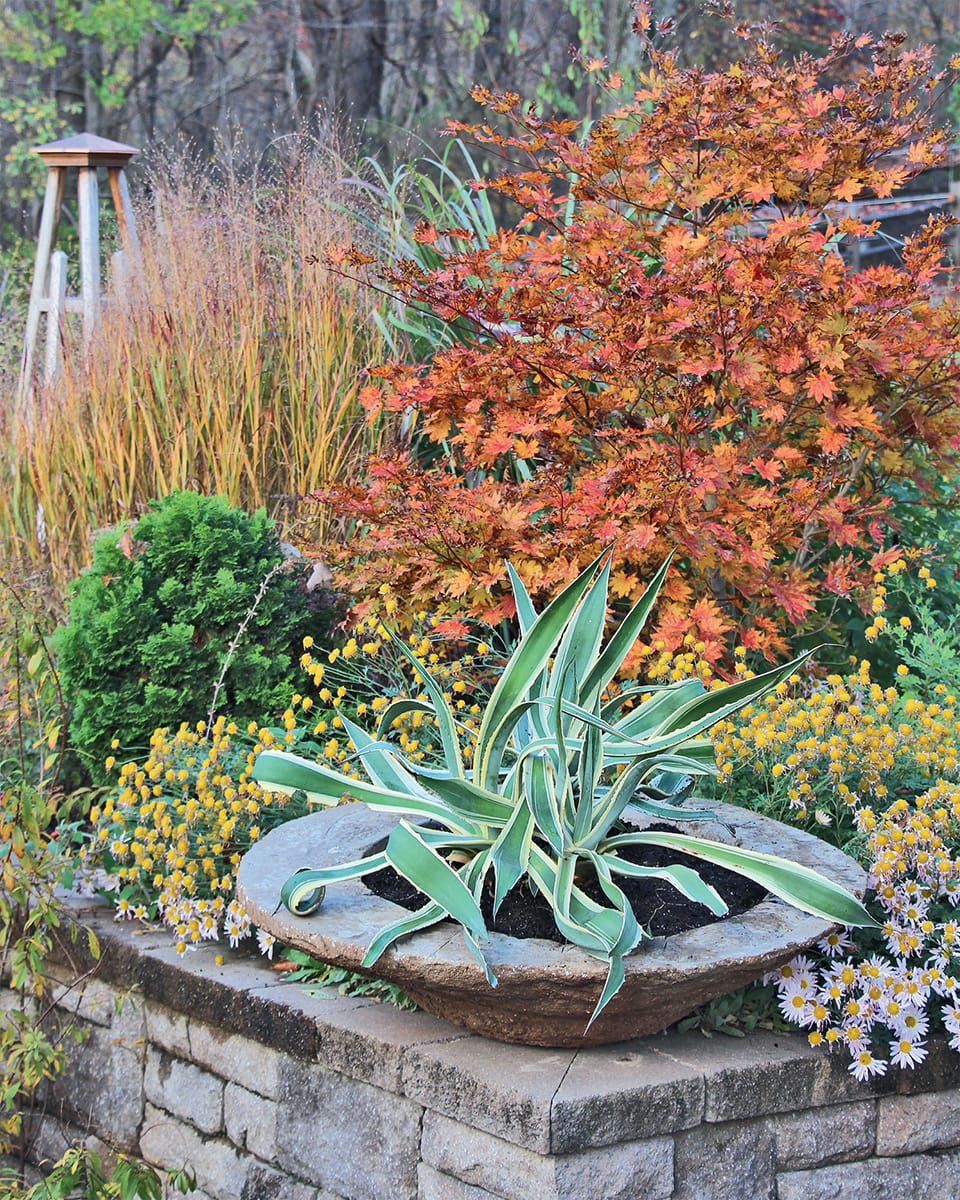
CHALLENGE #1: A BORING WINTER LANDSCAPE
Winter gardens are all too often devoid of color and structure. In the throes of the summer gardening season, we forget to consider what the garden will look like in the dead of winter; we’re too busy enjoying the fragrances and colors of flowering perennials and annuals to think about snow days. But when the blooms are gone, it’s important to have plants in the garden that capture the eye. Whether they have an evergreen growth habit, interesting bark, colored twigs, a unique form, beautiful berries, or some other winter attribute, these compact plants can help overcome a dull and boring winter landscape.
Compact plants to provide winter interest
1. SHERWOOD COMPACT MUGO PINE (PINUS MUGO ‘SHERWOOD COMPACT’): This very hardy evergreen pine is a true dwarf that has a mounded shape and candelabra-like branch growth. Its stems are covered with long needles, and a slow growth rate means no pruning is necessary to maintain the optimum size and shape. ‘Sherwood Compact’ reaches just 2 to 3 feet tall and wide and is winter hardy down to –50°F.
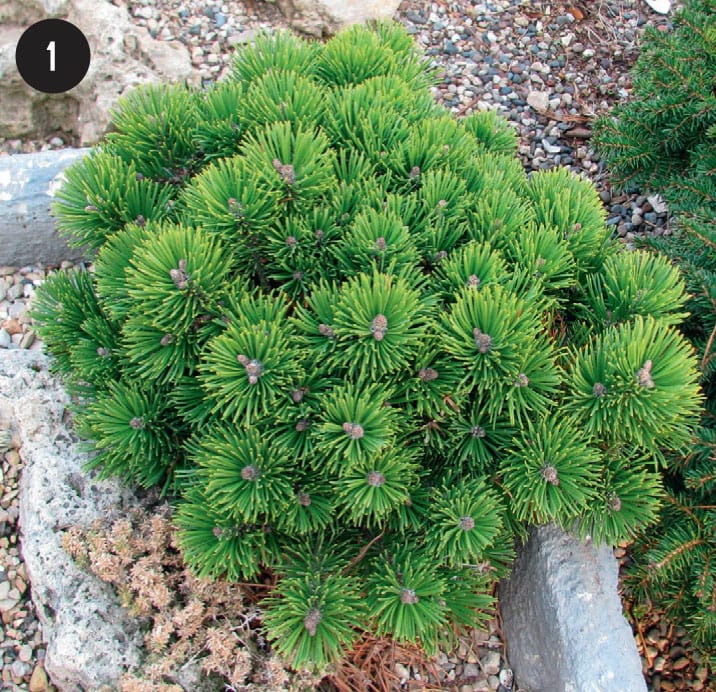
2. SOFT TOUCH INKBERRY (ILEX CRENATA ‘SOFT TOUCH’): ‘Soft Touch’ holly is winter hardy down to –20°F. It’s a mounded shrub that maxes out at just 2 to 3 feet tall and wide and requires little to no pruning; it’s perfect for tiny backyards. The foliage is dark green, and the small leaves make a lovely addition to the garden year round. Unlike some other hollies, ‘Soft Touch’s’ leaves do not have spines; their edges are soft and rounded.
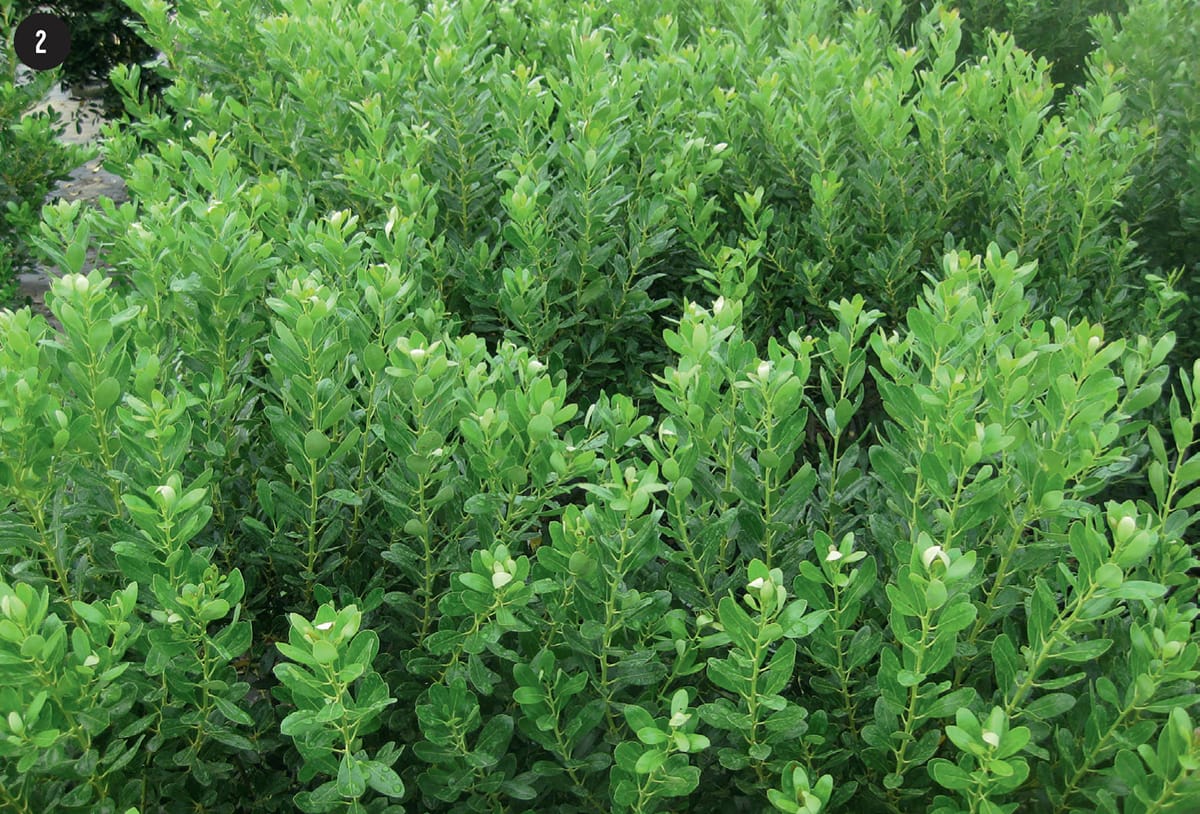
3. VANDEN AKKER WEEPING ALASKA CEDAR (CHAMAECYPARIS NOOTKATENSIS ‘VAN DEN AKKER’): Skinny is the best word to describe this columnar tree for small yards and gardens. The thinnest of all the weeping Alaska cedars, it reaches 20 feet tall but is only 1 foot wide! The short, tight branches weep, while the central trunk grows straight up. This extremely narrow evergreen tree has soft, fan-like growth and is a truly unique addition to any compact garden space. Winter hardy down to –20°F.

4. COMPACT CRANBERRY BUSH (VIBURNUM TRILOBUM ‘COMPACTUM’): This cultivar of the North American native cranberry bush, viburnum offers year-round interest. The new spring growth is tinged in red. It’s then followed by white, flat-topped flower clusters that form clusters of bright red berries in the fall. A quick growth rate means the 6-foot height and width is reached within a few years. Birds love the berries on this shrub, and it’s winter hardy down to –50°F.
5. MAGICAL® PINK CARPET SNOW BERRY (SYMPHORICARPOS ‘KOLMPICA’): An eye-catching beauty that shrugs off winters down to –30°F, this compact form of snow berry produces flowers in May and June. The blooms are followed by clusters of pink, chubby berries on the branch tips. Great for both containers and in-ground gardens, and topping out at just 3 feet tall and wide, Magical® Pink Carpet is nothing short of adorable.
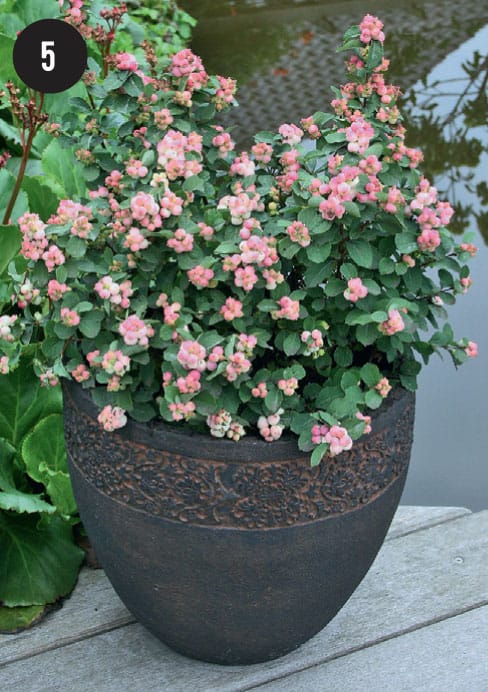
6. LITTLE GOBLIN® WINTERBERRY HOLLY (ILEX VERTICILLATA ‘NCIV1’): Winterberry hollies lose their leaves in the autumn, exposing densely packed, deep red berries on every branch that persist well into the winter. You’ll need a pollinator variety such as Little Goblin® Guy for this dwarf female shrub to produce berries. One male for every five female plants is ideal. Topping out at 3 to 5 feet with an equal spread, Little Goblin® can handle even damp, poorly drained soils and is winter hardy down to –40°F.
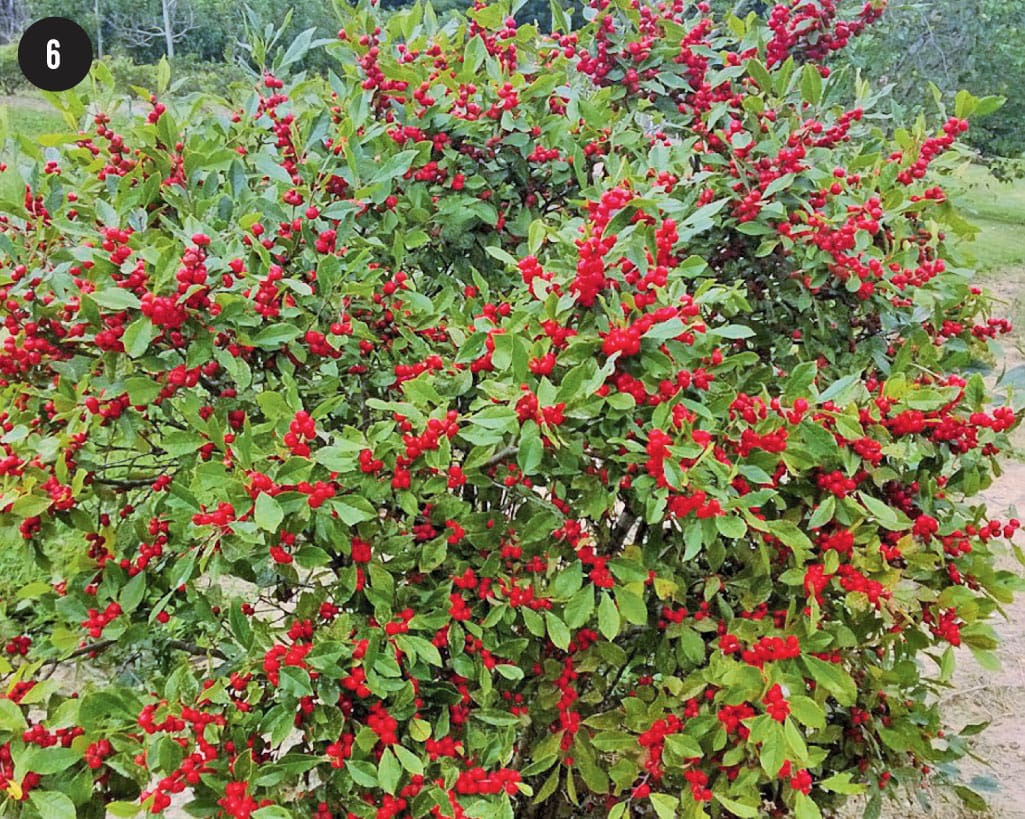
7. TWISTY BABY™ DWARF BLACK LOCUST (ROBINIA PSEUDOACACIA ‘LACE LADY’): The winter interest this tree offers is in the form of its contorted branches. A great specimen plant for a small garden or container, the unique twisted branches reach up to 10 to 15 feet in height, but you can prune to keep it smaller if needed. This deciduous tree’s leaves and leaf stems are curvy and twisty, too, with a hint of silver on their undersides. In spring, Twisty Baby™ is covered with drooping panicles of fragrant white flowers. Winter hardy down to –30°F.
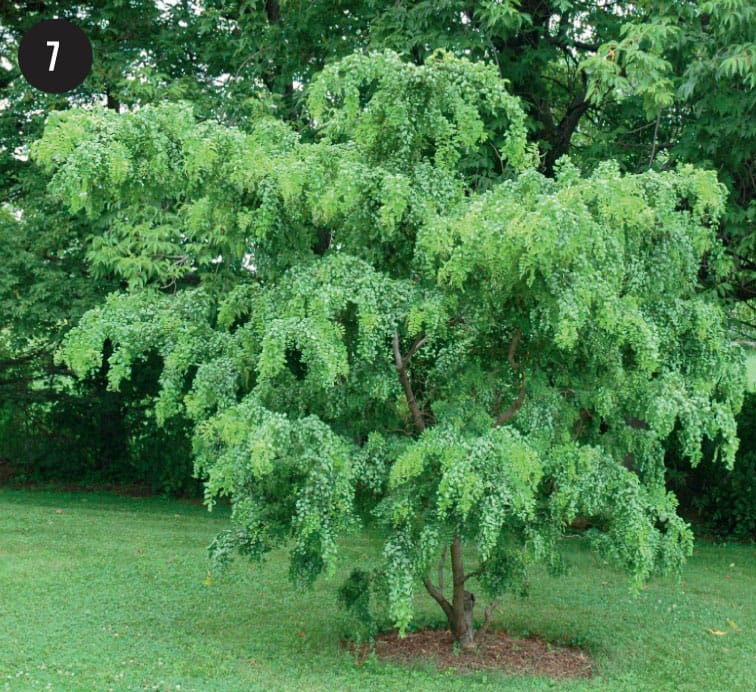
8. GOLDEN TUFTED HAIR GRASS (DESCHAMPSIA CESPITOSA ‘GOLDTAU’): The compact habit, long bloom time, and golden-yellow flower stalks, make this grass a garden champ. Tussocks of deep green foliage reach 1 to 2 feet tall and 2 to 3 feet wide. The airy flowers appear in summer and persist through the winter, providing interest and texture to the landscape. Winter hardy down to –30°F, golden tufted-hair grass tolerates hot and dry weather and is deer resistant, too.

CHALLENGE #2: A SLOPED SITE
I live in western Pennsylvania, where it’s difficult to find a yard that doesn’t have a slope. Level lots are tough to come by around here, and as a result, I’m often asked about the best way to handle a slope that’s too steep to mow. The answer, of course, is to fill it with compact plants!
While unmowable slopes have traditionally been the realm of groundcovers like pachysandra, myrtle, and creeping sedum, times have changed. With the introduction of numerous dwarf evergreens, flowering shrubs, roses, and perennials comes the opportunity to create beautiful gardens on sloped sites instead of just slathering them with a single groundcover destined to be overrun with grass and weeds before it fills in. Mixing various compact plants together in a thoughtful design allows homeowners to turn a troublesome area into a beautiful garden, and because these plants stay naturally compact, there’s no need to don your rock climbing gear to prune them every spring. As long as you can mulch the slope early in the season to limit weeds, these plants are fairly self-sustaining.
Compact plants to cover sloped sites
1. SHOW OFF® SUGAR BABY® FORSYTHIA (FORSYTHIA × INTERMEDIA ‘NIMBUS’): Winter hardy down to –20°F, this bright, compact forsythia has a lot to offer. Deer resistant with vase-shaped, pint-sized growth, Sugar Baby® produces canary yellow blooms on bare branches in very early spring. A slew of green, pest-proof leaves appear soon after. With a height and spread of 18 to 30 inches, this adaptable shrub makes a great slope cover.
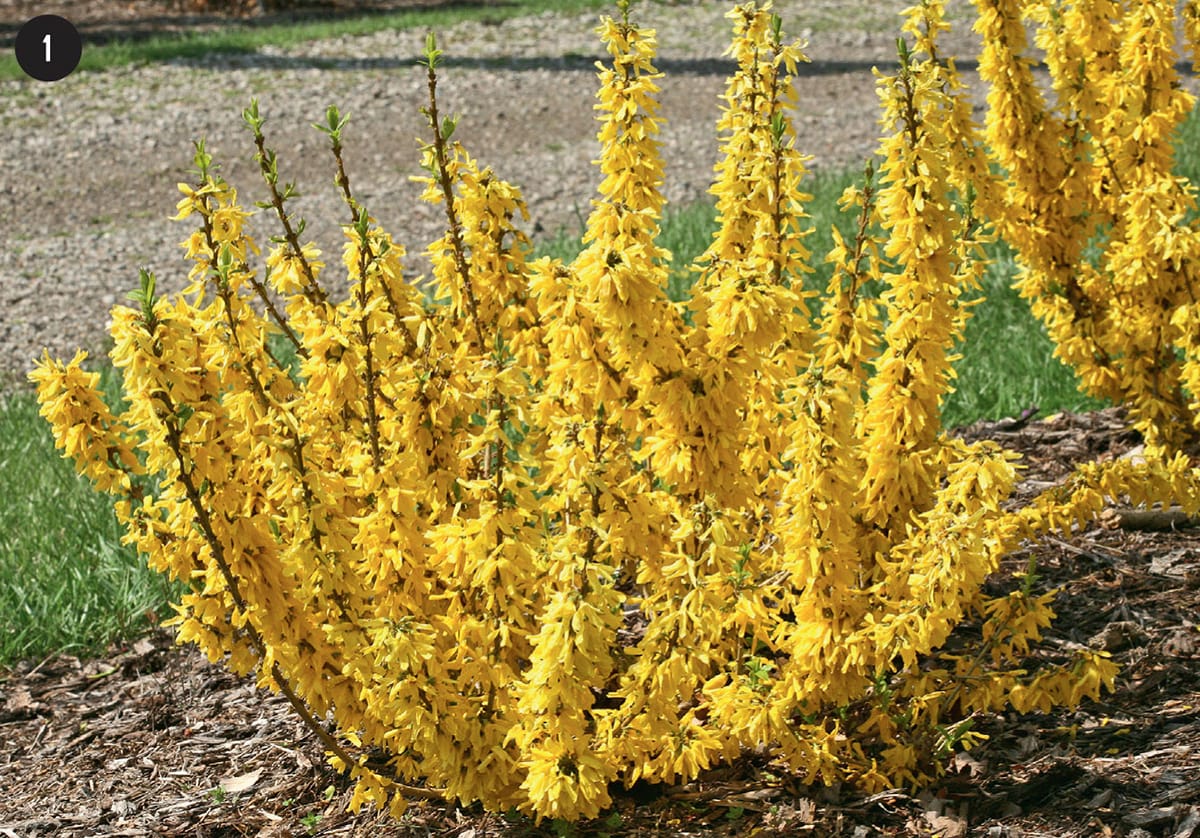
2. COMPACT PLUME JUNIPER (JUNIPERUS HORIZONTALIS ‘PLUMOSA COMPACTA’): Yet another excellent small shrub, this feathery, blue-green dwarf juniper reaches only 2 feet in height with double the spread. It makes a great evergreen groundcover and looks lovely all winter long. Surviving winters down to –40°F, ‘Plumosa Compacta’ is no wimpy little plant.
3. WABI SABI® VIBURNUM (VIBURNUM PLICATUM VAR. TOMENTOSUM ‘SMVPTFD’): Topping out at just 2 to 3 feet in height, with an equal spread, Wabi Sabi® is a total doll. This dwarf version of the classic doublefile viburnum we all know and love is low and wide, making it perfect for covering slopes, lining walkways, and sprucing up foundation plantings. It’s fairly shade tolerant, too. With strong horizontal growth, white, flat-topped spring flowers, and excellent fall color, there’s not a single thing to dislike about this shrub. Winter hardy down to –20°F.
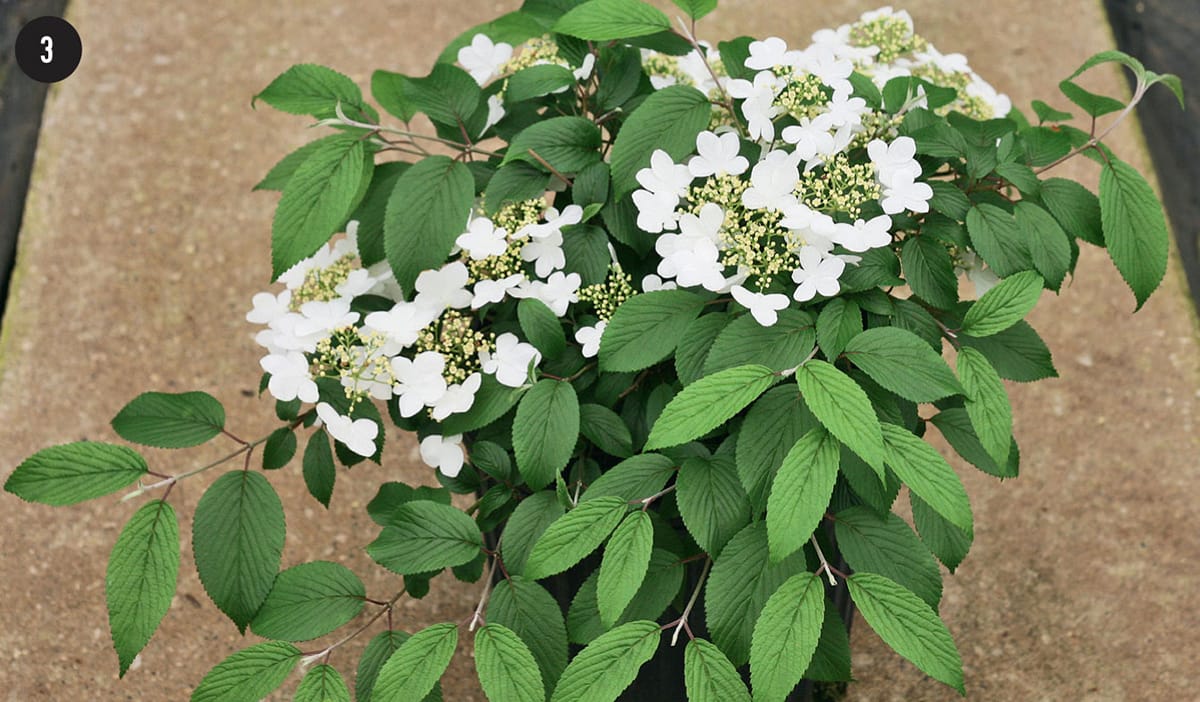
4. DWARF ENGLISH BOXWOOD (BUXUS SEMPERVIRENS ‘SUFFRUTICOSA’): This dwarf boxwood is a prime garden plant for so many reasons. Its compact growth habit (it matures at just 2 to 3 feet tall and wide), slow growth rate, and impeccable form make it a great choice for small and large gardens, alike. The deer-resistant foliage does need some protection from strong winter winds to avoid winter dieback where winters are very cold, but it’s fully winter hardy down to –20°F. The evergreen, glossy leaves are 1 inch long and quite dense along the stems.
5. DRIFT® ROSES (ROSA HYBRID DRIFT® SERIES): If ever there were a rose to overcome challenging sites in small gardens, the Drift® rose is it! With nine different available varieties, this 2-feet-tall and 3-feet-wide rose comes in a wide range of colors. Its spreading growth habit makes it perfect for mass plantings or for use as a groundcover. The disease-resistant foliage produces repeated clusters of blooms every 5 to 6 weeks, all season long. There’s no need to deadhead this rose, either. Just prune it hard in the early spring and then put your pruners away for the rest of the year. With a winter hardiness down to –20°F, this is a no-fail rose for small-space gardeners.
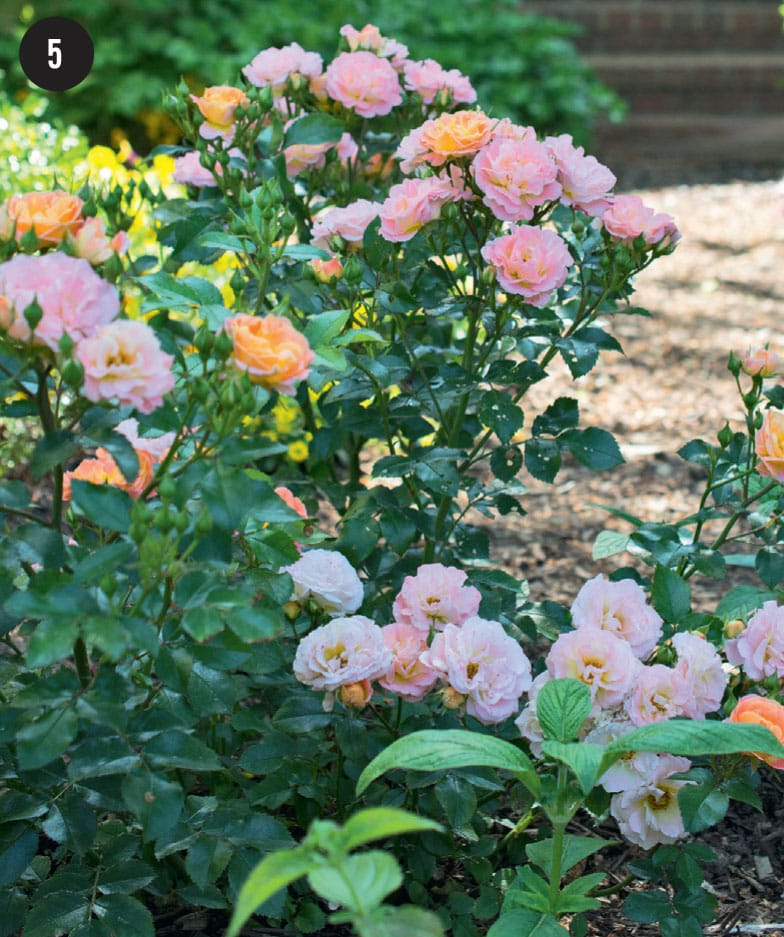
6. LITTLE GRAPETTE DAYLILY (HEMEROCALLIS ‘LITTLE GRAPETTE’): Everyone loves reliable and tough-as-nails daylilies, right? While full-sized varieties may prove to be too large for smaller landscapes, ‘Little Grapette’ is right at home. A clump-former with slender, grass-like leaves, this 16-inch-tall daylily bears purple flowers with a yellow/green throat. It produces several flushes of new blooms throughout the growing season, so it’s far from a one-trick pony. Winter hardy down to –30°F, ‘Little Grapette’ is ideal for mass and specimen plantings, alike.
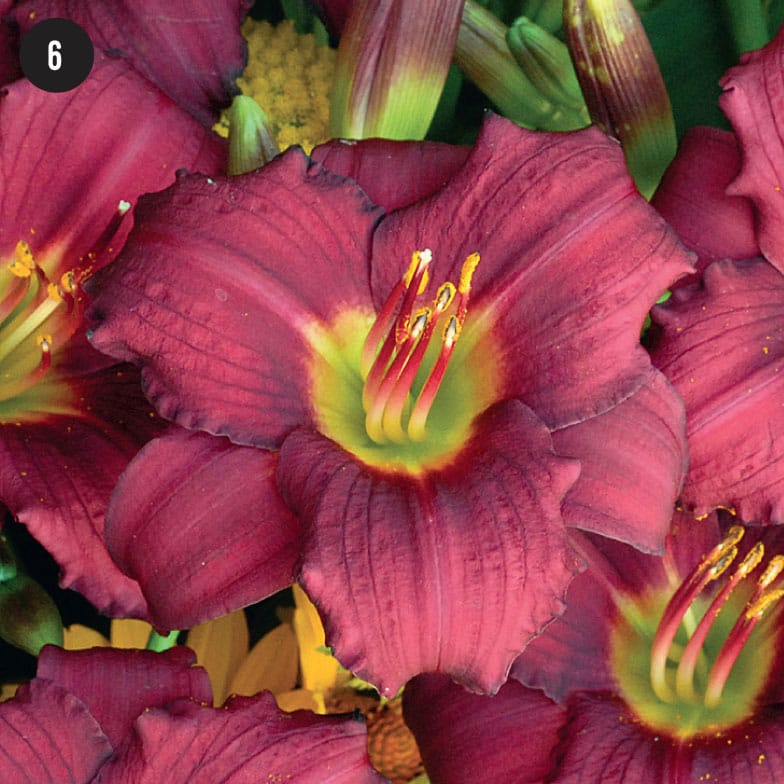
7. JUNIOR WALKER™ CATMINT (NEPETA × FAASSENII ‘NOVANEPJUN’): This compact catmint is a personal favorite for hot, dry, sloped gardens and perennial borders. Its maximum height is 18 inches with double the spread, making it ideal for covering a lot of ground in a very low-maintenance way. Smothered in purple-blue flower spikes in spring and summer, the fragrant, blue-tinged foliage is also deer and rabbit resistant. Winter hardy down to –20°F, Junior Walker™ is a favorite of bees and other pollinators. Plus, it’s drought tolerant, too.
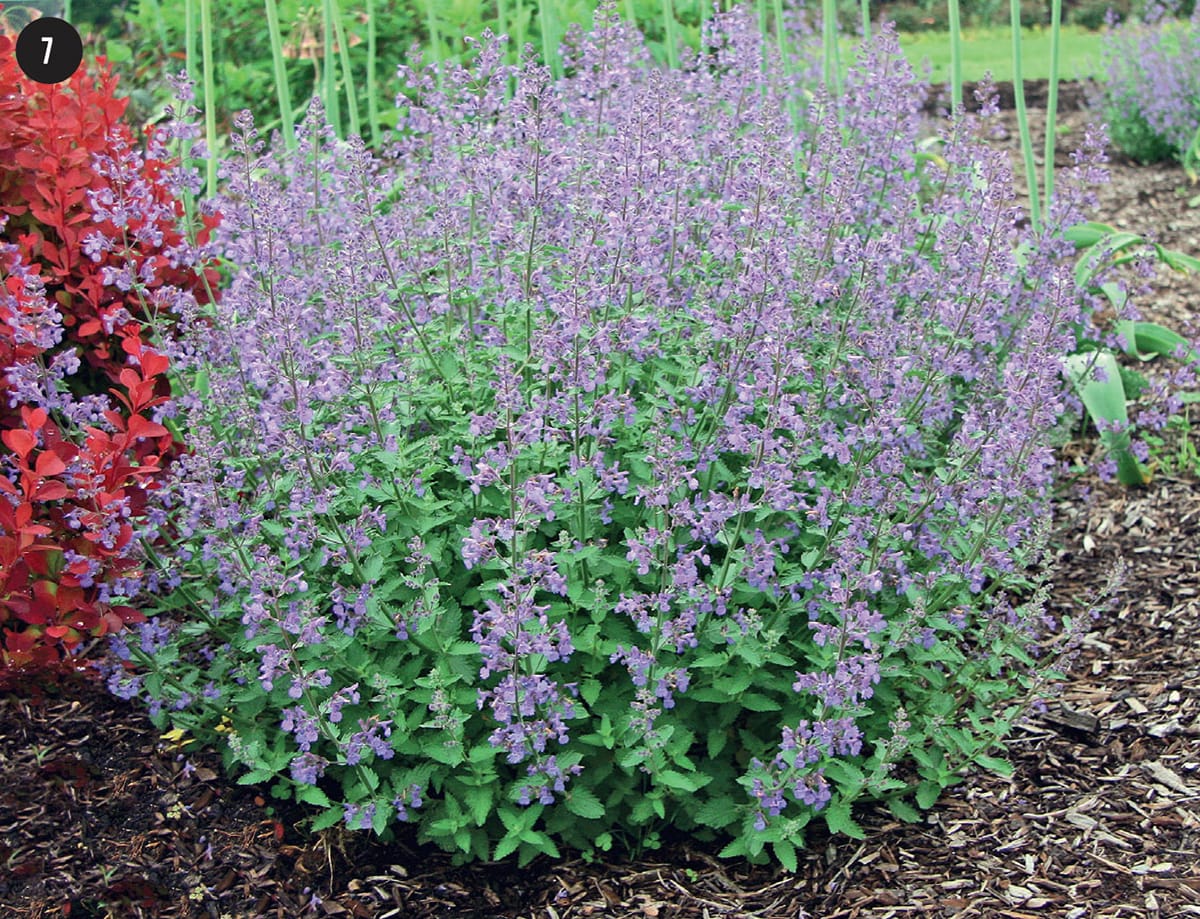
8. COMPACT PFITZER JUNIPER (JUNIPERUS CHINENSIS ‘KALLAY’S COMPACT’): An improved, compact form of the Pfitzer juniper, ‘Kallay’s Compact’ reaches just 3 feet tall and 6 feet wide. This evergreen is a vigorous grower with dense branching, which makes it great for a low hedge or slope planting. The horizontal-spreading branches are attractive year-round. Winter hardy down to –30°F, this evergreen is also said to be deer resistant.
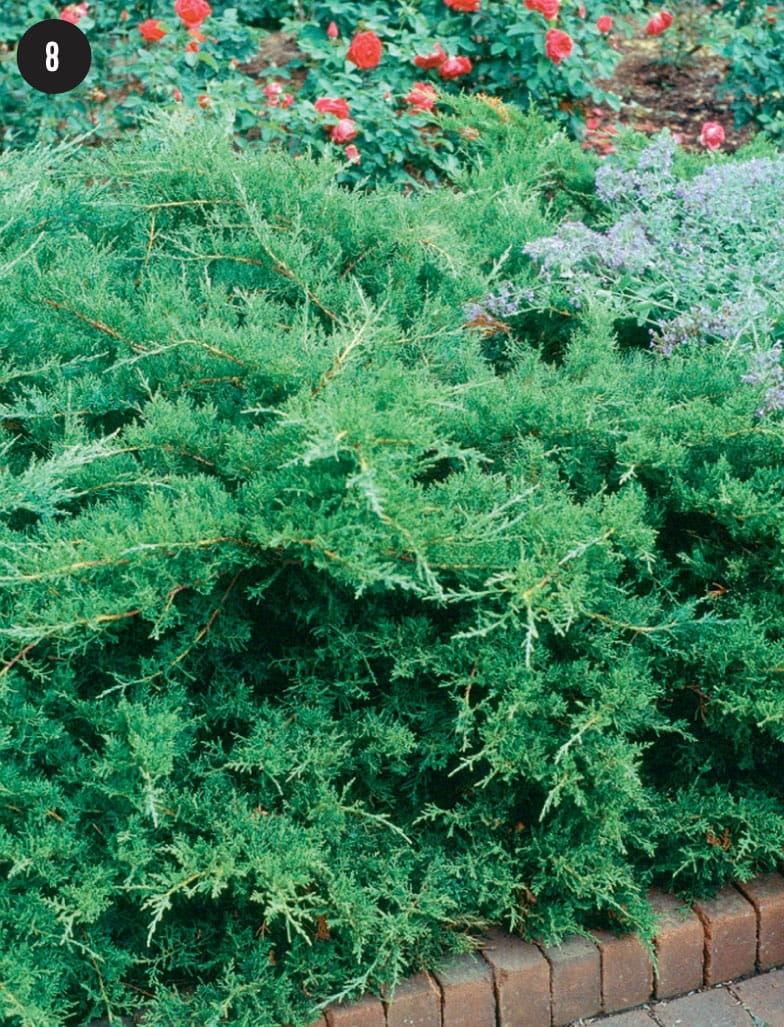
CHALLENGE #3: AN UNSIGHTLY VIEW
Whether you’re aiming to block the neighbor’s pool or keep their poodle out of your yard, plants can solve your problem. The list of plants typically recommended for privacy screening and hedging includes some pretty large specimens that can quickly overtake a small backyard or urban landscape. While frequent pruning is one way to keep these plants more compact, there are better, lower-maintenance options now available to small-space gardeners. The varieties included here all have narrow growth habits, making them easy to space close together to create a privacy screen or hedge. Though a few of the plants I recommend here grow quite tall, most urban gardens are not “vertically challenged.” There’s plenty of room to grow up, so tall, narrow plants often work quite well. If that’s not the case where you live, though, be sure to choose one of the shorter options.
Compact plants to provide privacy screening and hedging
1. SKY PENCIL HOLLY (ILEX CRENATA ‘SKY PENCIL’): This narrow, upright evergreen is a smooth-leaved holly that reaches about 6 feet in height but is only 2 to 3 feet wide. Like other hollies, the male and female plants are separate. The females of this species produce tiny purple berries but only when a pollinating male plant is nearby. ‘Sky Pencil’ hollies are lovely trees for small gardens, and their evergreen growth habit means they provide winter interest, too. Winter hardy down to –20°F.

2. GREEN SPIRE EUONYMUS (EUONYMUS JAPONICUS ‘GREEN SPIRE’): Winter hardy down to –10°F, ‘Green Spire’ euonymus is well behaved, giving it a more formal appearance than some other options. The glossy, green foliage is perfect for creating a narrow hedge or screen. Maxing out at 6 to 8 feet in height with a spread of just 1 to 2 feet, this naturally narrow shrub is a fast grower, too.
3. COLUMNAR SWEDISH ASPEN (POPULUS TREMULA ‘ERECTA’): A thin cultivar of the Swedish aspen tree, this variety is an exceptional choice for slender garden areas and small yards. It’s very cold hardy (down to –50°F) and has heart-shaped leaves that move in the wind. Though it’s deciduous and loses its leaves in the winter, this columnar tree’s structure is lovely even sans foliage. Its width is very limited, but it can grow up to 40 feet tall.

4. DAKOTA PINNACLE® BIRCH (BETULA PLATYPHYLLA ‘FARGO’): The Dakota Pinnacle® birch is a columnar tree with leaves that turn a brilliant yellow in the fall and white, peeling bark. It’s also resistant to the bronze birch borer, which is another definite plus. Among the most statuesque of all the columnar trees for small gardens, the Dakota Pinnacle® birch grows upwards of 25 feet tall at maturity but is only 8 to 10 feet wide. Winter hardy down to –40°F, this birch is lovely as both a specimen tree and, when planted close together, a privacy screen.

5. DWARF HORNBEAM (CARPINUS BETULUS ‘COLUMNARIS NANA’): Though hornbeams are fairly rigid, narrow trees to begin with, this variety is even more well behaved. These winter hardy trees (down to –30°F) are like perfect garden sculptures that reach only 6 feet tall at full maturity. The slow growth rate of ‘Columnaris Nana’ means it takes a long time for that to happen, which is yet another trait that makes this tree a must for small gardens. Rich, medium green leaves grace the branches; they turn a brilliant yellow in the autumn.

6. CRIMSON SPIRE™ OAK (QUERCUS ROBUR × Q. ALBA ‘CRIMSCHMIDT’): This unique oak tree is very tall—up to 40 feet—but it remains fairly narrow at just 10 to 15 feet wide (yes, that’s quite narrow for an oak!). The fall color is exceptional. A stunning tree all around, but an especially valuable tree for small gardens due to its ability to support a wide array of native insects and the songbirds who eat them. Fully winter hardy down to –20°F, several Crimson Spire™ oaks planted in a row make a striking privacy screen or tall windbreak.
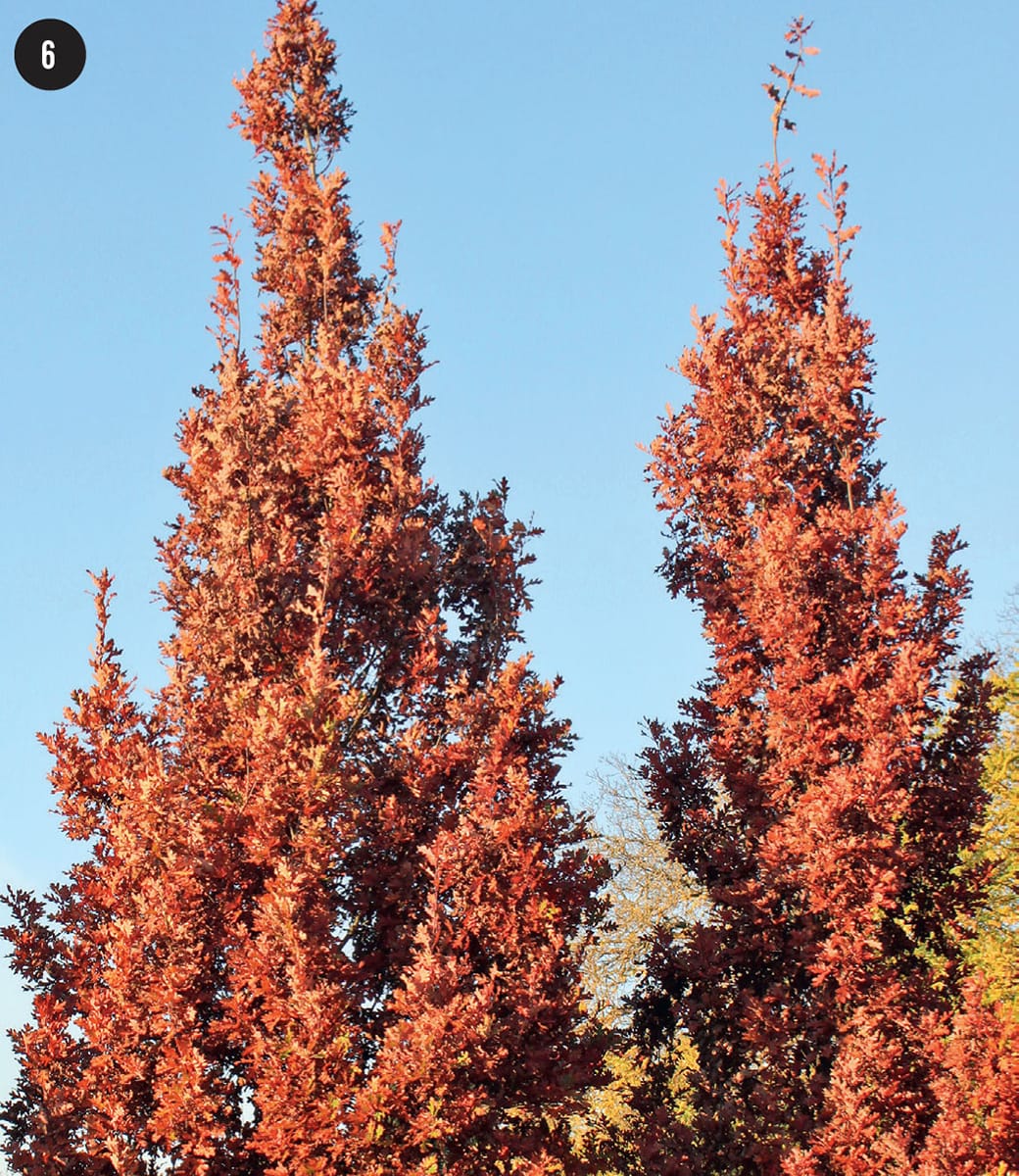
7. STANDING OVATION LITTLE BLUESTEM (SCHIZACHYRIUM SCOPARIUM ‘STANDING OVATION’): Though this ornamental grass grows tall, its habit is quite narrow, making it perfect for adding height to slender spaces. The sturdy, upright stems are tinted blue with a hint of dark burgundy at their base. With an excellent fall color and a winter hardiness down to –40°F, ‘Standing Ovation’ is a vertical accent unlike any other. Silvery flower stalks grace the plant in the late summer. Tolerant of lousy soils, the only care this ornamental grass needs is to be cut down to a height of 6 inches in the very early spring.
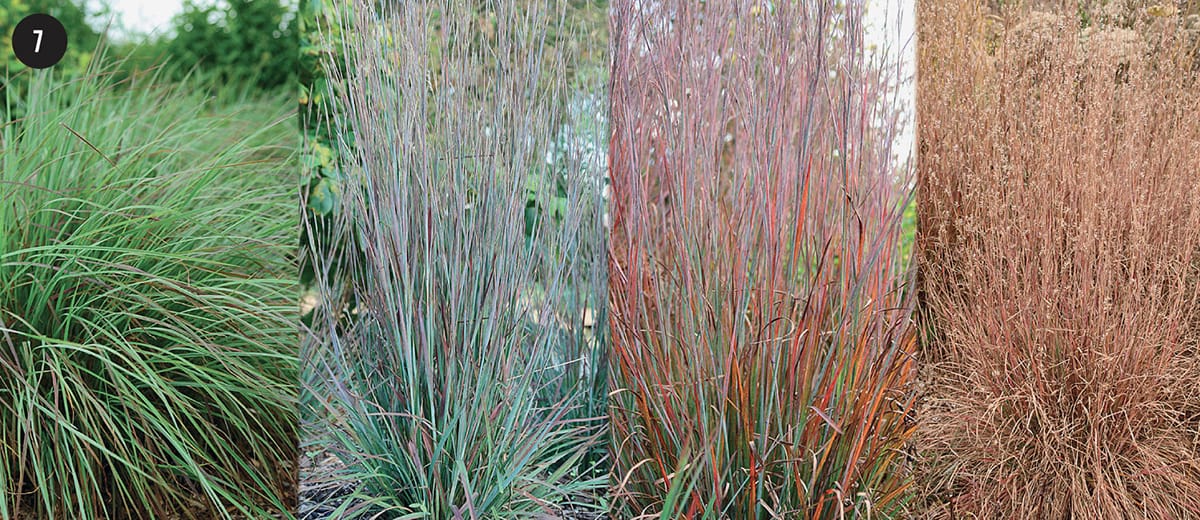
8. FEATHER REED GRASS (CALAMAGROSTIS × ACUTIFLORA ‘KARL FOERSTER’): Another ornamental grass for hedging and privacy screening, the narrow, upright growth of ‘Karl Foerster’ has been a garden favorite for many decades. Winter hardy down to –20°F, this grass reaches a height of 3 to 4 feet and a spread of 18 to 24 inches. The bright green leaves and feathery plumes of beige to pink flowers on upright stalks are both deer resistant and low maintenance. Simply cut the plants down to 6 inches in the early spring. No other care is necessary.
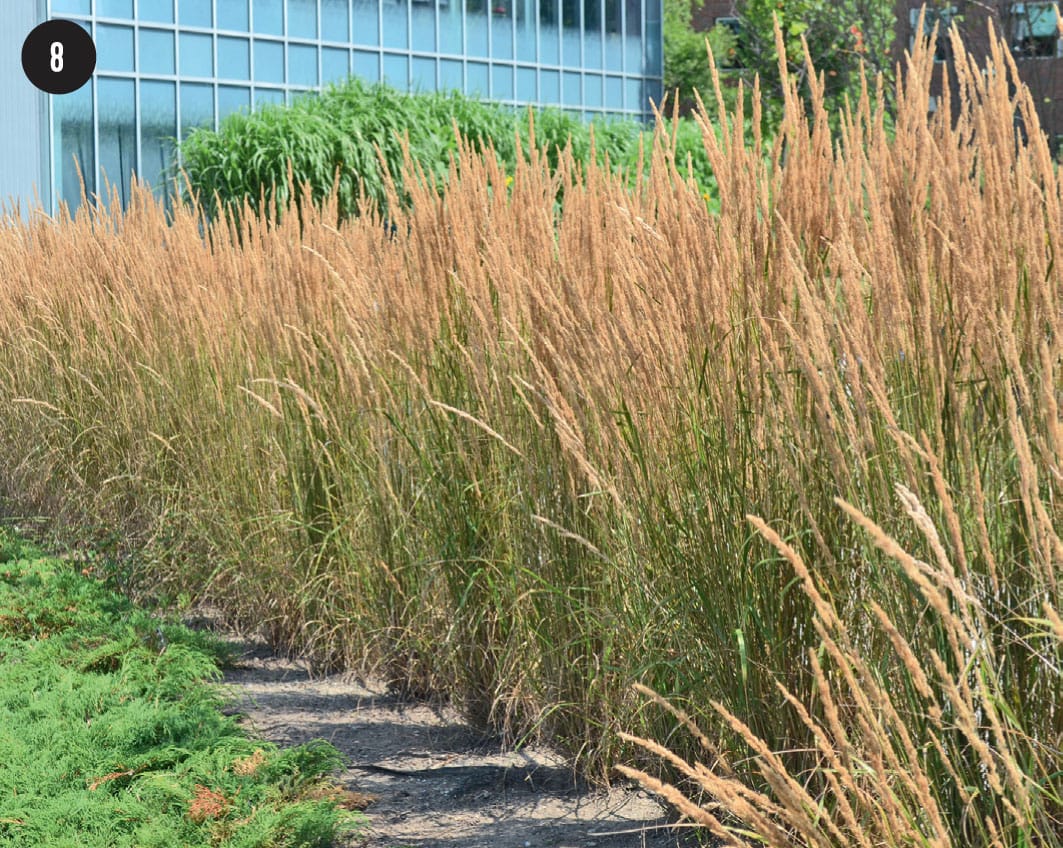
CHALLENGE #4: A COLORLESS GARDEN WITH NO PIZZAZZ
If you ask a homeowner what trait they value the most in their garden, they’re likely to give a hearty nod to color. Colorful flowers are the mainstay of most gardens, and smart gardeners aim to have a few different plants in bloom from early spring all the way through fall’s first frost (and beyond if you live in a warmer climate). However, you’d be wise to remember that color doesn’t always equate to blooms. While a flowering perennial or shrub may be in bloom for only a few short weeks, vivid plant foliage can provide months of color. One of the easiest ways to pump up the volume of a garden is to incorporate a few different foliage colors into the mix. There are dozens of plants with foliage that’s chartreuse, pink, burgundy, white, purple, yellow, bronze, rust, red, orange, and everything in between. Don’t be afraid to use a few of these plants to add more color your landscape.
Whether you’re adding color through flowers, foliage, or a combination of both, here are some bold and beautiful compact plants with an endless supply of pizzazz to perk up even the dullest landscape. Some are meant to offer season-long foliage color, while others lend a bright hue through their blooms.
Compact plants to add brightness to a drab garden
1. POPROCKS™ RAINBOW FIZZ™ SPIREA (SPIREA JAPONICA ‘MATGOLD’): This super fun flowering shrub has compact foliage that’s copper colored in the spring and then matures to a bright yellow-green with red tips. In spring and early summer, the branch tips host flat-topped, inch-wide clusters of bright pink flowers. Due to their fuzzy appearance, the flower clusters look like little fizzy pink clouds. With the ability to handle temperatures down to –40°F, Rainbow Fizz™ is 3 to 4 feet tall and wide at maturity.

2. JAZZ HANDS® VARIEGATED CHINESE FRINGE-FLOWER (LOROPETALUM CHINENSE ‘IRODORI’): Prized for its unique-colored foliage, this shrub is among the most striking compact plants you can add to your landscape. Winter hardy down to 0°F, the leaves of this variegated Chinese fringe-flower are white and pink upon emergence in the spring, but they mature to a rich, dark purple. Pink, fringe-like flowers occur on stem tips in the mid-spring. A height of 4 to 6 feet with a 4-foot spread means this shrub stays naturally pint sized, but if you want to keep it even smaller, a quick trim just after the blooms fade will do the trick.
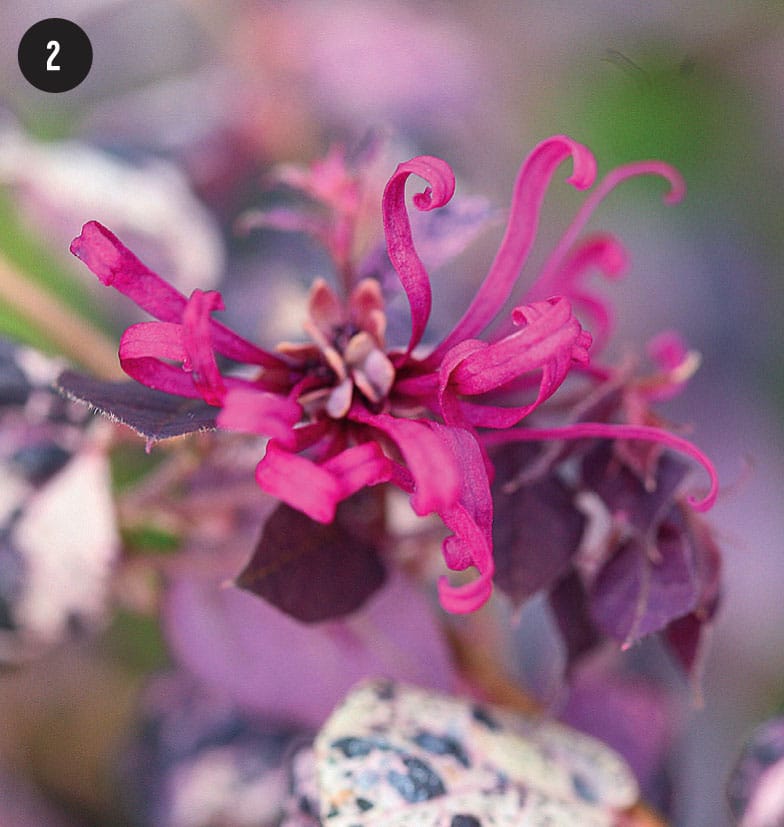
3. WINECRAFT BLACK® SMOKE BUSH (COTINUS COGGYGRIA ‘NCC01’): The misty, smoke-like bloom clusters of smoke bush have been a favorite of gardeners for generations, but most cultivars grow way too large for urban gardens. Winecraft Black®, however, tops out at just 4 to 6 feet tall and wide. The merlot-colored leaves turn near black in the summer and develop an orange/red hue in the fall. Winter hardy down to –30°F, this smoke bush has a naturally rounded habit.

4. RAZZLE DAZZLE® DWARF CRAPE MYRTLE (LAGERSTROEMIA ‘GAMAD VI’): Crape myrtles are the darlings of almost every gardener south of the Mason-Dixon Line. While crape myrtle trees are stunning, they outgrow the confines of a smaller garden in short order. Instead, those with limited space should turn to dwarf cultivars like this one instead. Mildew resistant and reaching just 3 to 4 feet tall and wide, Razzle Dazzle® features large heads of hot pink/purple blooms in early summer. Winter hardy down to –10°F, it’s an excellent choice for mass plantings. If you garden in a colder climate, opt for growing it in a container that can be overwintered in a garage.
5. SIZZLE & SPICE™ THREADLEAF COREOPSIS SERIES (COREOPSIS VERTICILLATA CULTIVARS): This series of dwarf coreopsis are known for their compact growth habit and prolific blooms. The Sizzle & Spice™ series is host to several different varieties that come in shades of pink, yellow, orange, and red, among several bi-colors. Maxing out at just 1 to 11/2 feet tall and surviving winters as low as –20°F, the daisy-like blooms are produced in abundance in early summer and should be sheared off when spent to generate another flush of blooms.

6. ARIZONA SUN BLANKET FLOWER (GAILLARDIA × GRANDIFLORA ‘ARIZONA SUN’): Gorgeous, 2-inch-wide flowers with red petals edged in yellow and red centers grace this plant every summer in droves. Forming a tidy mound of lance-shaped foliage, ‘Arizona Sun’ is an excellent pollinator plant that stands 12 inches tall and 15 inches wide. Though it dislikes wet, clay-based soils, the plant easily survives winters down to –40°F and brings tons of bold color to the garden.
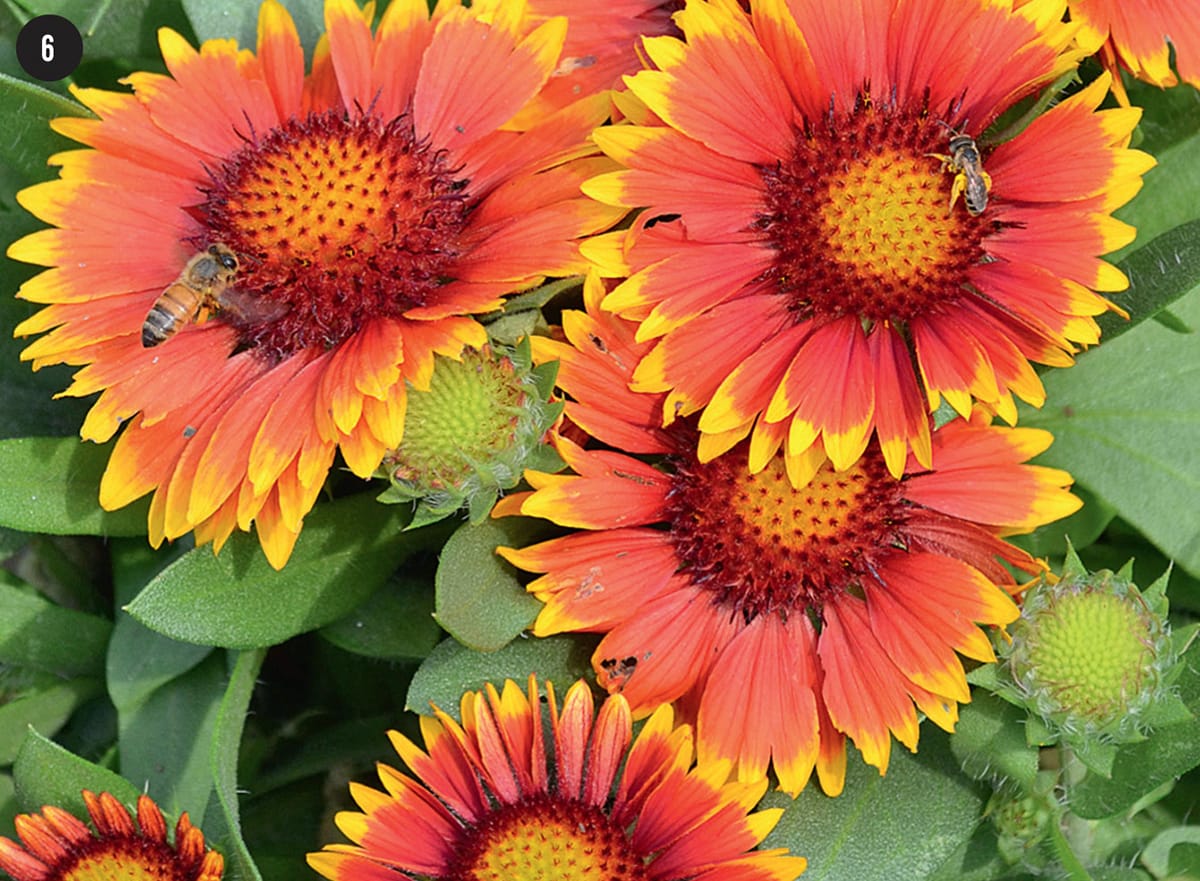
7. DWARF GOLDENROD (SOLIDAGO SPHACELATA ‘GOLDEN FLEECE’): If a late-season pop of color is a need for your garden, this plant delivers. An easy-to-grow cultivar of a favorite North American native plant, ‘Golden Fleece’ dwarf goldenrod does not spread like crazy, unlike some other goldenrods do. Sprays of tiny yellow flowers grace the 12-inch-tall plants in the early fall. This plant is an important nectar source for bees and butterflies, and with a hardiness down to –30°F, it’s a welcome addition to almost every garden.

8. MARCUS FLOWERING SAGE (SALVIA NEMOROSA ‘MARCUS’): Winter hardy down to –30°F and standing just 6 inches tall and 10 inches wide, this micro salvia is packed with flair. Purple spires of flowers top the plants in the late summer and fall, and the pollinators absolutely adore them. Deer resistance, drought tolerance, and a clump-forming habit add to the list of this plant’s many attributes. An exceptionally colorful plant, if you shear Marcus’s spent blooms off, another flush of blooms occurs soon after.
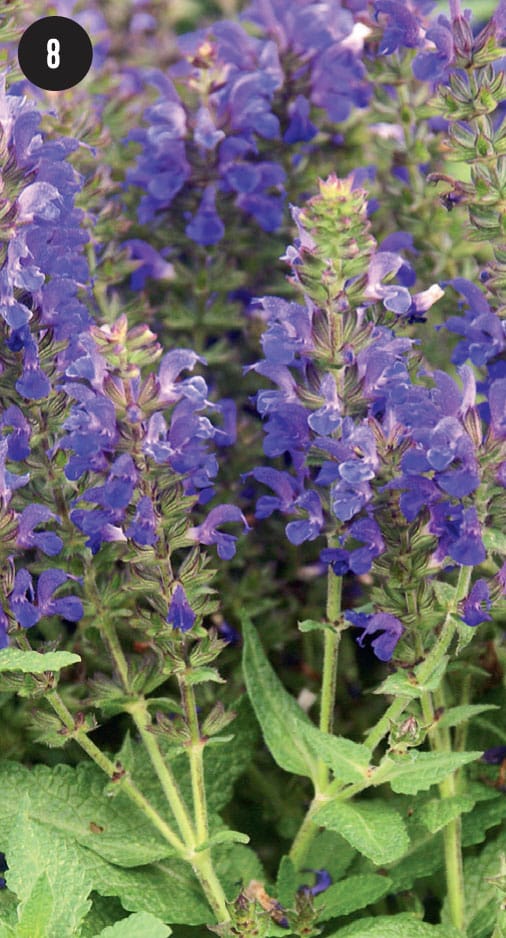
CHALLENGE #5: TOO MUCH SHADE
A classic example of “the grass is always greener on the other side,” I often find that gardeners with lots of shade are constantly wishing they had more sun. But, there are so many wonderful plants that thrive in the shade; it’s time to embrace those dark, shadowy corners of the garden and appreciate them for what they are.
Plants adapted to woodland environments and understory edges are perfect fits for these areas. The good news is that so many of these types of plants are naturally petite, so there isn’t always a need to seek out specific compact varieties. But if you’re looking for pint-sized versions of some favorite shade plants, here are a handful that I covet.
Compact plants to jazz up shady areas
1. INVINCIBELLE MINI MAUVETTE® HYDRANGEA (HYDRANGEA ARBORESCENS ‘NCHA7’): A neat little cultivar of our North American native smooth hydrangea, Mini Mauvette® grows just 2 to 3 feet tall and wide. The ball-shaped flower clusters occur on new wood, so there’s no way you can prune this shrub incorrectly, as long as you do it in the spring. The strong stems mean the massive mauve-pink blooms are held upright without staking. This lovely hydrangea prefers a touch of morning sun and survives winters down to –40°F.

2. LAVALAMP™ FLARE™ PANICLE HYDRANGEA (HYDRANGEA PANICULATA ‘KOLMAVESU’): Another adaptable and petite hydrangea that’s winter hardy down to –40°F, Lavalamp™ Flare™ produces big, conical flower clusters that are white and age to a brilliant pink. Each upright flower panicle can grow up to 16 inches long! With a mature height of just 2 to 3 feet, that means over half of the plant’s height is flowers! Perfect for tiny backyards and containers with limited sun.
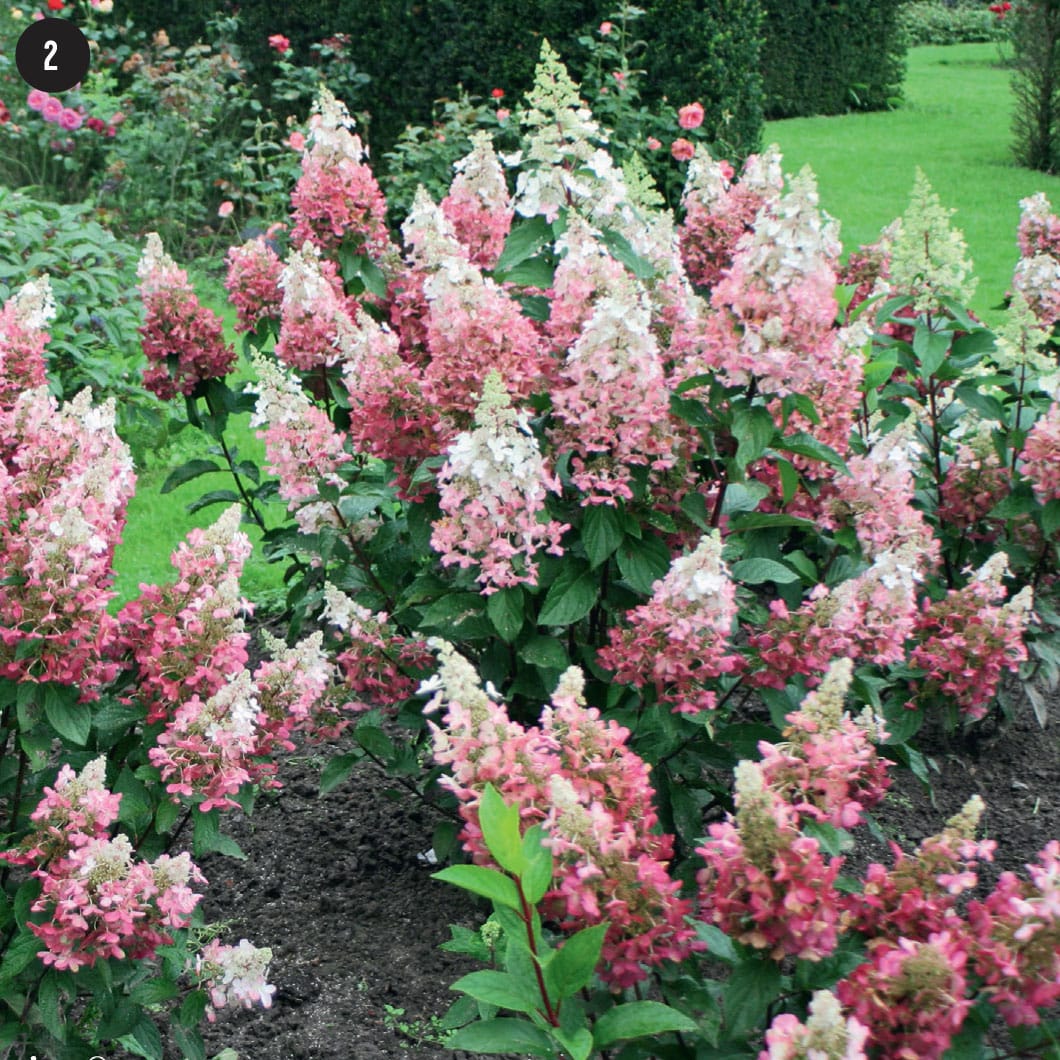
3. COMPACT BLUE HOSTA (HOSTA ‘HALCYON’): Yes, there are a million different hostas out there, and yes, there are many dwarf and miniature varieties, but this old standby is one of my personal favorites. Thick, paddle-shaped, blue leaves and a slow growth rate to a height of 18 inches combine to make this a choice variety for small yards. Winter hardy down to –40°F, ‘Halcyon’ holds its blue color even in summer’s heat. A few other mini hostas worth seeking out are ‘Appletini’, ‘Bitsy Gold’, ‘Dew Drop’, and ‘Blue Elf’.
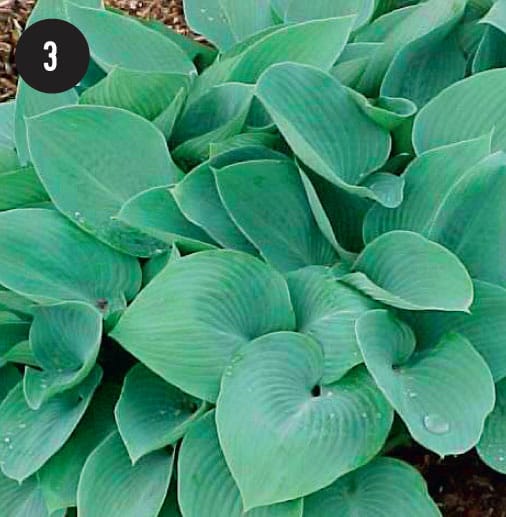
4. DWARF CHINESE ASTILBE (ASTILBE CHINENSIS VAR. PUMILA): This sweet little astilbe is far from a new variety, but it sure is a stellar one. Spikes of pinky-purple blooms stand rigid above green, ground-hugging leaves. Often used as a groundcover when densely planted, this low-growing variety thrives in the shade but can handle some sun, too. The bloom spikes reach 10 inches tall, and, with time, the plants will spread several feet wide. Winter hardy down to –30°F, this deer-resistant, pollinator-friendly plant is a must for adding a punch of color to shady gardens.
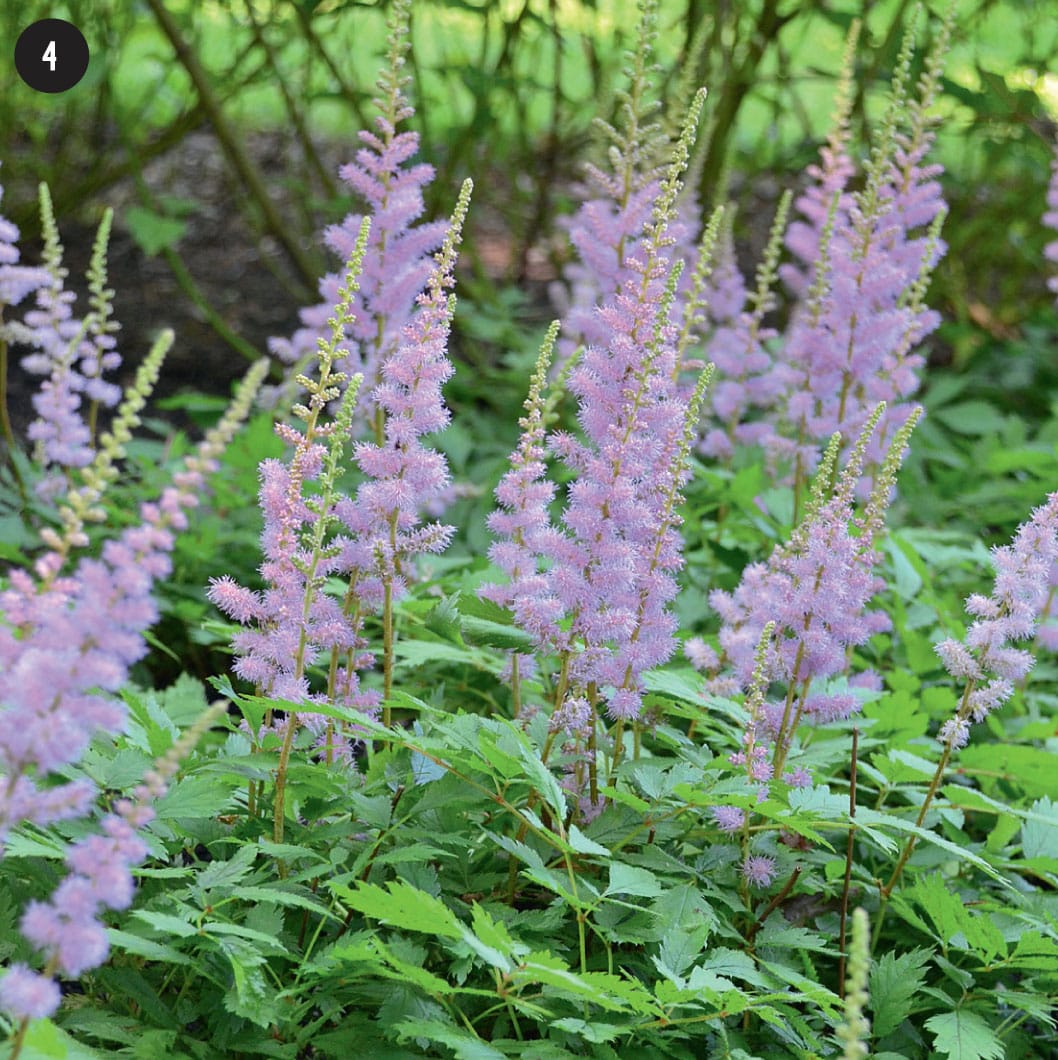
5. ASTILBE ‘LOOK AT ME’ (ASTILBE × ARENDSII ‘LOOK AT ME’): ‘Look at Me’ is a dwarf astilbe that has definitely earned its name. In bloom from early to midsummer and winter hardy down to –40°F, the cotton candy pink, wispy flower spikes occur on red stems that stand 18 inches above the low foliage. Small in stature but big on impact, moist soils and shady spots are best for this variety.
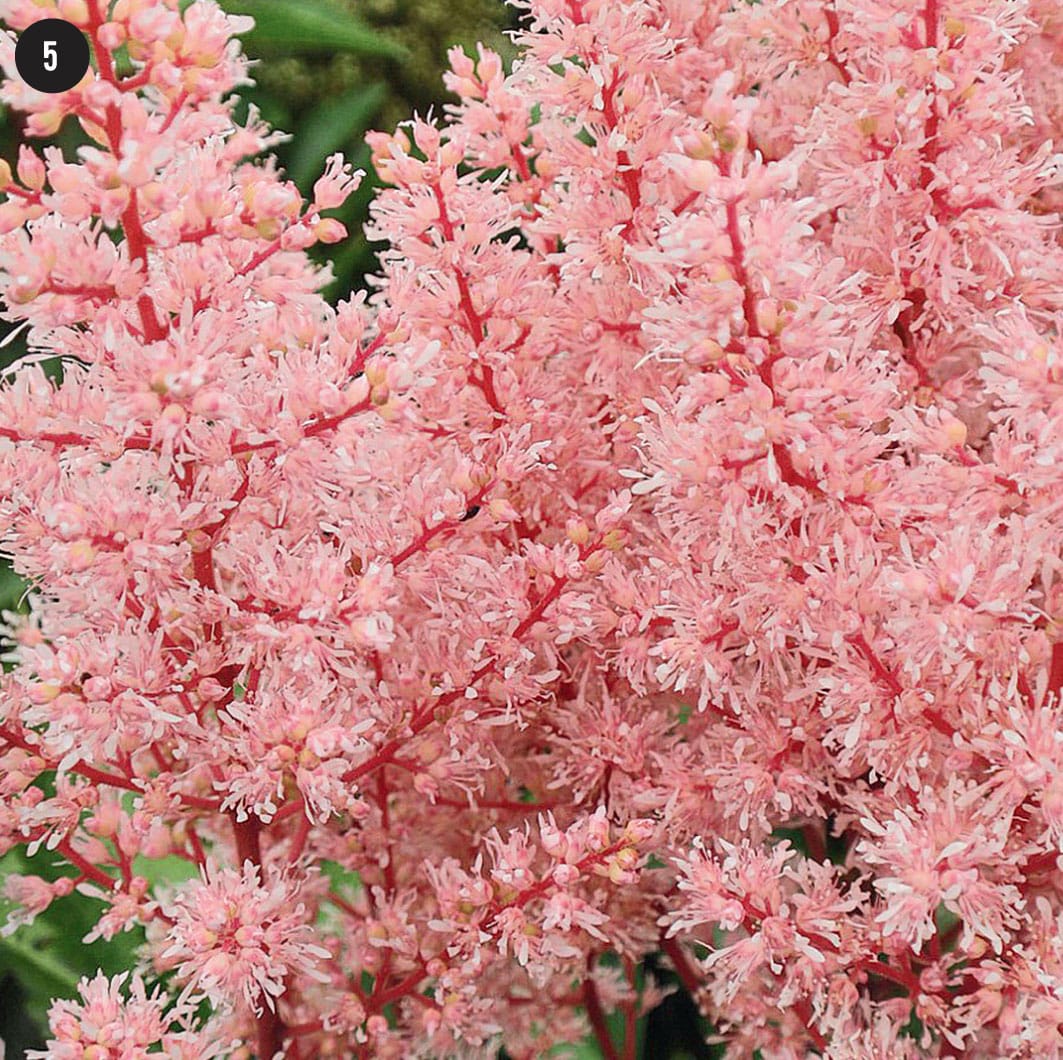
6. RED PYGMY® DOGWOOD (CORNUS FLORIDA ‘RUTNUT’): For those seeking a small flowering tree that thrives under the shade of larger trees, your search is over. This tiny version of the American flowering dogwood produces full-sized, deep pink to red blooms in the spring. The foliage is disease resistant and turns a rusty red in the fall. Red Pygmy® grows to just 8 feet in height with a 6-foot spread, but its slow growth rate means it will take up to 10 years to reach maturity. This petite and truly lovely tree from Rutgers University’s breeding program is winter hardy down to –20°F. Another alternative is ‘Rosy Teacups’ American dogwood.
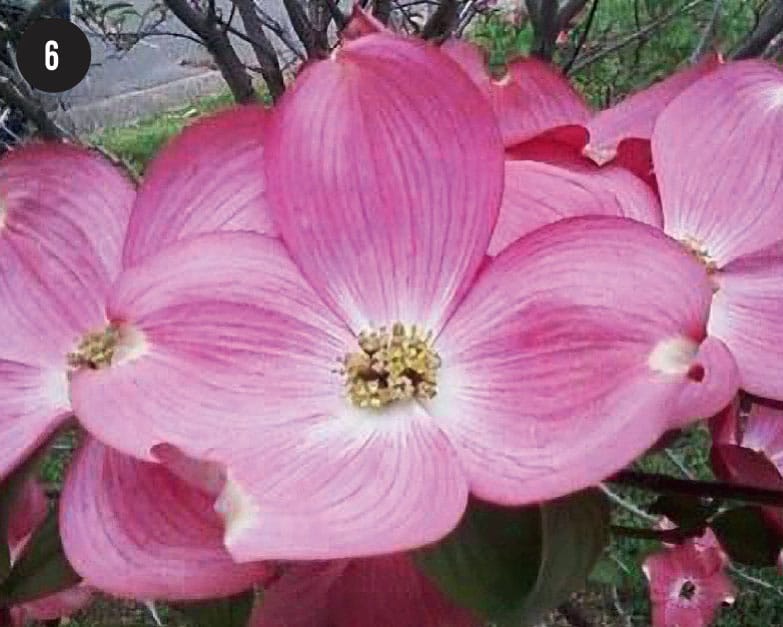
7. COMPACT GOLD-EDGED TOAD LILY (TRICYRTIS FORMOSANA ‘GILT EDGE’): In full and glorious bloom from August to September, this compact toad lily produces white, orchid-like blooms with purple speckles in branched clusters at the stem ends and upper leaf axils. The broad leaves are shiny and green with a creamy-white to chartreuse edge. Topping out at just 18 inches tall with a spread of up to 24 inches, this perennial spreads naturally but does not become invasive and survives winters down to –20°F.
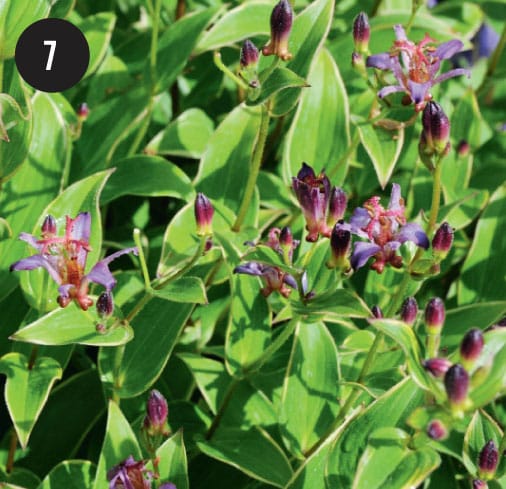
8. LITTLE LANTERNS COLUMBINE (AQUILEGIA CANADENSIS ‘LITTLE LANTERNS’): A miniature selection of our North American native columbine, the nodding, bright red and yellow flowers occur in late spring. The nectar-filled spurs on the back of the flowers are a favorite of hummingbirds returning from their overwintering sites. Winter hardy down to –40°F, ‘Little Lanterns’ reaches just 10 inches tall and thrives in full to partial shade. Long-blooming for a columbine (up to a month!), this variety also self-sows quite nicely, increasing the colony slowly over time.

CHALLENGE #6: MINIMAL TEXTURE IN THE LANDSCAPE
The next time you visit a botanical garden or head out on a garden tour and see a garden that really appeals to you, step back and examine the plantings and think about what makes them so effective. In many cases, you’ll find that the most interesting plant combinations aren’t the result of big, blousy blooms or colorful foliage. Instead, it’s the combination of various plant textures that really catches the eye. The strappy, upright, sword-like foliage of one plant combined with the soft, wispy texture of another often yields far more interest than two brightly colored flowers planted side by side ever could. Bringing a diversity of plant textures to the landscape is a must for ensuring there’s season-long interest in a garden.
Here are some excellent plants to add more texture to a garden. You can use them as your “texture echo” or just pop them in between existing plants to add more interest wherever it’s needed.
Compact plants to add more texture to the garden
1. MAGICAL® SNOW DROPS PEARL BUSH (EXOCHORDA ‘SNOW DROPS’): This beautiful little deciduous shrub hits just 3 to 4 feet tall and equally as wide. Its compact form makes it perfect for small garden areas. Clusters of delicate white flowers emerge from round, pearl-like buds late in the spring, followed by yellow autumn color late in the season. Winter hardy down to –30°F and loving conditions from full sun to part shade, this compact pearl bush blooms for 3 to 4 weeks every spring. Its soft, graceful texture looks beautiful in shrub beds and flower borders.

2. CHAMAECYPARIS LAWSONIANA ‘WISSEL’S SAGUARO’: A slow-growing tree unlike anything else you’ve ever seen, this funky plant is straight out of a Dr. Seuss book! The upright branches look a bit like a saguaro cactus, hence the cultivar’s name. This unique false cypress is evergreen and reaches a height of about 10 feet with a spread of just 6 to 8 feet. In my opinion, it’s the most unique of all the trees for small gardens. It’s winter hardy down to –30°F.

3. BANANA BOAT BROAD-LEAVED SEDGE (CAREX SIDEROSTICHA ‘BANANA BOAT’): Sedges are great choices for full to part shade, but this cultivar grows to just 10 inches tall and wide. Deer resistant and tolerant of moist soils, the bright yellow and green variegate foliage of this grass-like plant gracefully bow across the garden, adding a soft texture that’s totally touchable. With an almost bamboo-like appearance, ‘Banana Boat’ is excellent for edging shady beds and adding brightness to containers, too. The foliage dies back in the winter, but the plants readily survive down to –20°F.
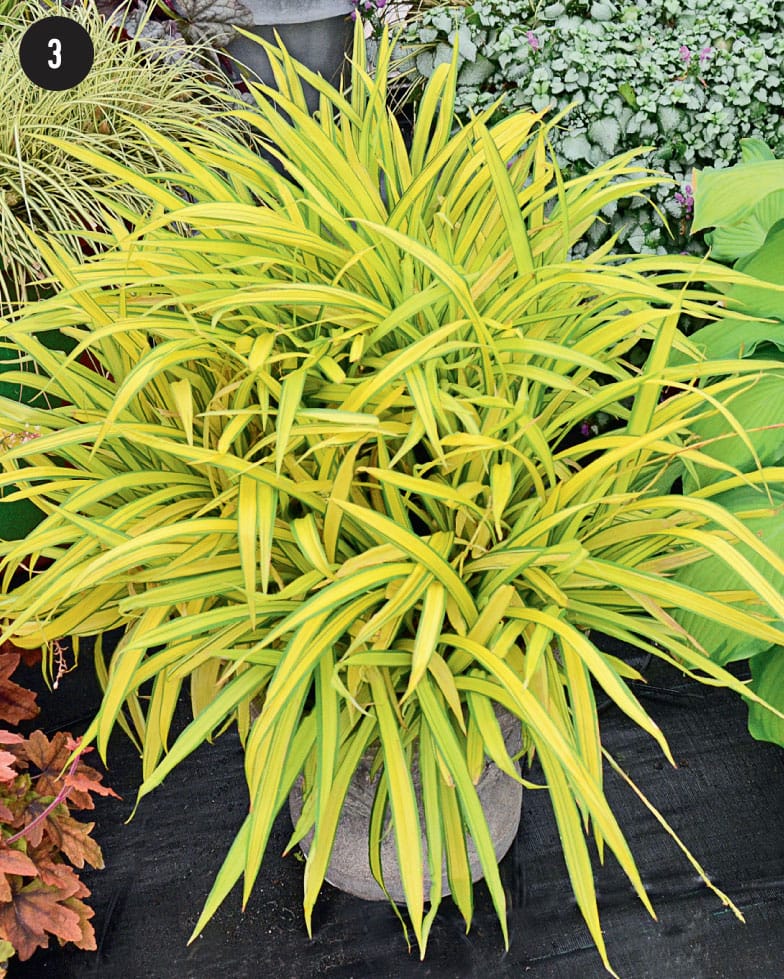
4. DWARF HINOKI CYPRESS (CHAMAECYPARIS OBTUSA ‘NANA GRACILIS’): A compact, extremely slow-growing, soft-needled evergreen with a somewhat pyramidal form, dwarf Hinoki cypress have fan-shaped foliage that’s lush and dark green and gives the plant an almost feathery texture. Winter hardy down to –30°F and reaching 3 to 5 feet tall and 2 to 3 feet wide over the course of many years, this evergreen requires full to partial sun and well-drained soils.
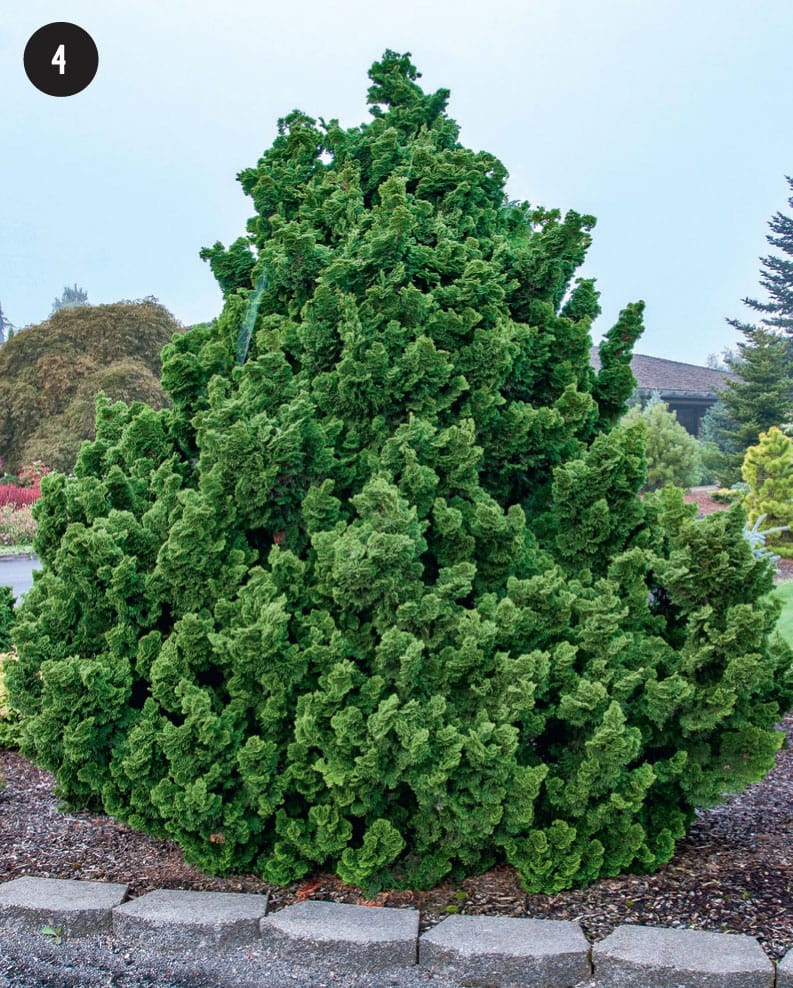
5. DWARF PINK SPEEDWELL (VERONICA SPICATA ‘GILES VAN HEES’): Spikes of bright pink appear in midsummer above the dark green upright foliage of this neat and tidy perennial. A compact cultivar that reaches only 6 inches tall with a 10-inch spread, ‘Giles Van Hees’ requires full sun. Its spiky texture is a great counterpoint to plants with soft, billowy flowers. Slow spreading and winter hardy down to –40°F, the blooms attract pollinators, too.

6. BLUE DENIM DWARF BEARDED IRIS (IRIS PUMILA ‘BLUE DENIM’): ‘Blue Denim’ is a spring bloomer whose sword-like foliage adds great texture to perennial borders and beds, even when the plants aren’t in bloom. Mature at 12 to 18 inches tall, this iris produces early-spring blooms and is winter hardy down to –30°F. The flowers are ruffled and denim blue, and it blooms several weeks earlier than taller varieties. This miniature perennial should be planted with the top of the thick root (rhizome) sticking out above the soil.
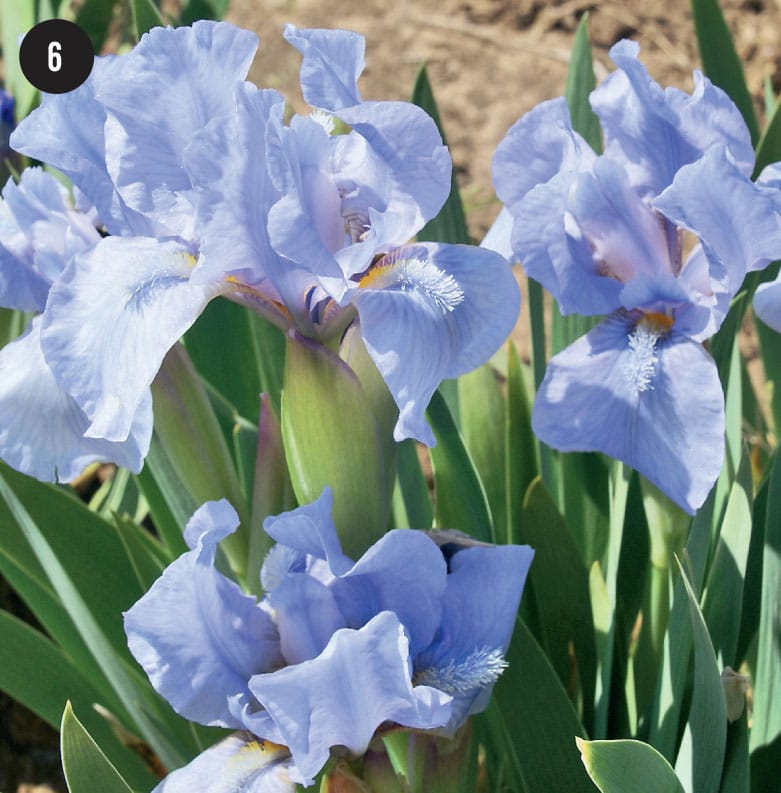
7. DWARF JOE-PYE WEED (EUPATORIUM DUBIUM ‘LITTLE JOE’ [SYN. EUTROCHIUM DUBIUM ‘LITTLE JOE’]): Fuzzy clusters of mauve blooms top the stiff, upright stems of this compact perennial in late summer. At one-third to one-half the height of traditional Joe-pye weed, ‘Little Joe’ is a bee and butterfly magnet. A cultivar of a North American native plant that thrives in average to wet garden soils, it maxes out at just 3 to 4 feet tall and 1 to 3 feet wide, so no staking is required. The blooms add an airy texture to the garden late in the season, and the plants are winter hardy down to –40°F.
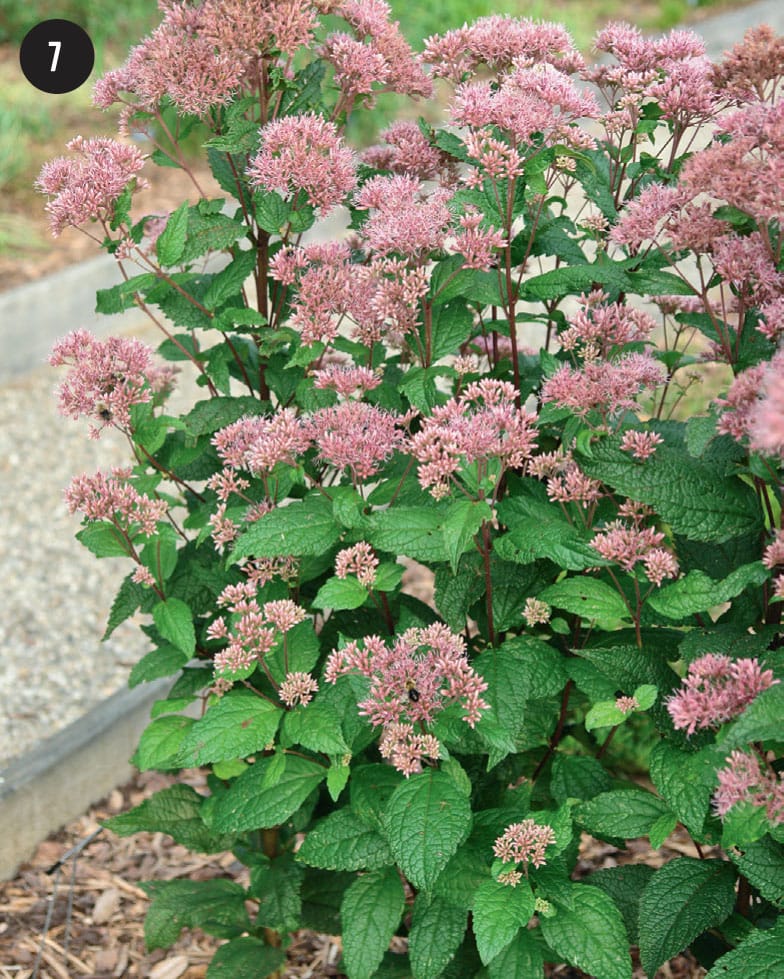
8. TWOMBLY’S RED SENTINEL JAPANESE MAPLE (ACER PALMATUM ‘TWOMBLY’S RED SENTINEL’): Though most Japanese maples are wide spreading, this cultivar boasts very upright growth, making it one of the best trees for small gardens and tight spaces. The foliage is a striking, deep red in spring and summer; even the stems are red. ‘Twombly’s Red Sentinel’ maxes out at 15 feet in height and spreads just 6 feet wide. Winter hardy down to –20°F, the palm-shaped leaves of this deciduous tree lighten to a bright crimson red in the autumn. Its slow growth rate means this variety will take many years to reach maturity.

CHALLENGE #7: LACK OF EVERGREEN PLANTS FOR YEAR-ROUND INTEREST
Evergreen plants have much to offer. Not only do they provide four seasons of visual interest to the garden; they also serve as windbreaks, increase privacy, and provide food and shelter for birds and other wildlife. Unfortunately, most home landscapes include the same five or six evergreens, most of which grow way too large for smaller gardens. The constant pruning these plants require makes them high maintenance and labor intensive. Why fuss with full-sized evergreens like yews, arborvitaes, spruces, and rhododendrons that reach all the way up to the eaves of your house when the following compact evergreen shrubs provide all the benefits of the “big guys” but in a much more manageable package?
Compact plants that are evergreen
1. COMPACT MAXIMUM RHODODENDRON (RHODODENDRON ‘MAXIMUM COMPACTA’): A mini version of a traditional rhododendron, this broad-leaved evergreen produces large clusters of pinkish lavender flowers in late spring. A low-growing, bushy plant, it makes a great addition to foundation plantings and shrub borders that receive full to partial sun. Reaching just 3 feet tall and wide, bumblebees love the flowers and are often found buzzing around the blooms. With winter hardiness down to –40°F, there’s no pruning necessary to maintain the shrub’s natural shape and size. Another compact rhododendron worth seeking out is the purple-flowered ‘Ramapo’.

2. COMPACT INKBERRY HOLLY (ILEX GLABRA ‘COMPACTA’): Another dwarf evergreen, this shrub is densely branched with elongated, oval leaves that are a dark, glossy green. This variety is female and will also produce small, dark berries that persist on the plant through winter if a pollinating male variety is nearby. It’s fairly deer resistant, too, making it a good choice for deer-plagued landscapes. Winter hardy down to –30°F, compact inkberry makes an excellent hedge or foundation plant. With a thick, twiggy habit that tops out at 4 to 6 feet in height and spread, it can also be regularly pruned to be kept even smaller.
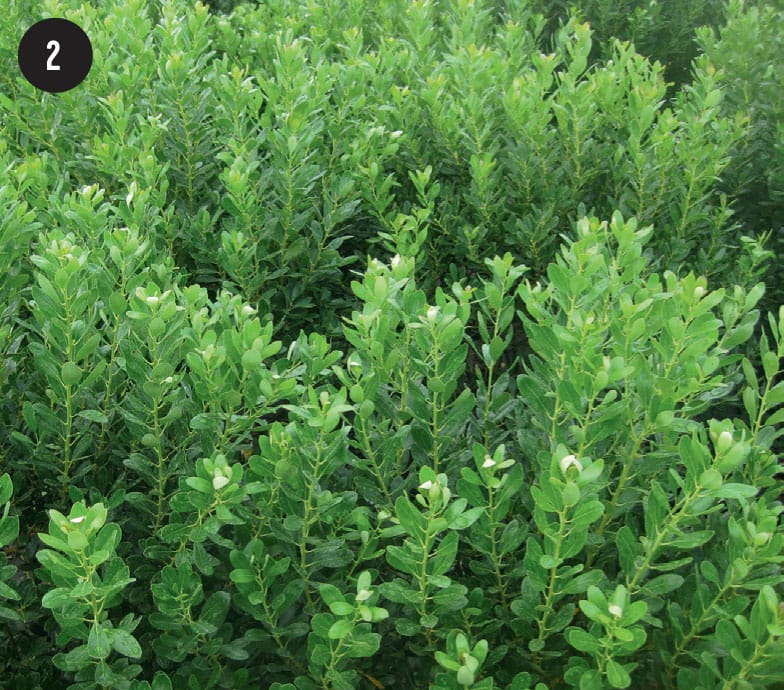
3. DWARF JAPANESE BLACK PINE (PINUS THUNBERGII ‘KOTOBUKI’): Fully winter hardy down to –20°F, this needled evergreen reaches just 4 feet tall and 2 feet wide. The upright candles of new growth in the spring, coupled with its narrow growth habit, make this an excellent choice for containers and small gardens. Slow growing, with a dense structure, this deer-resistant evergreen has needles that are about half the length of regular Japanese black pines.
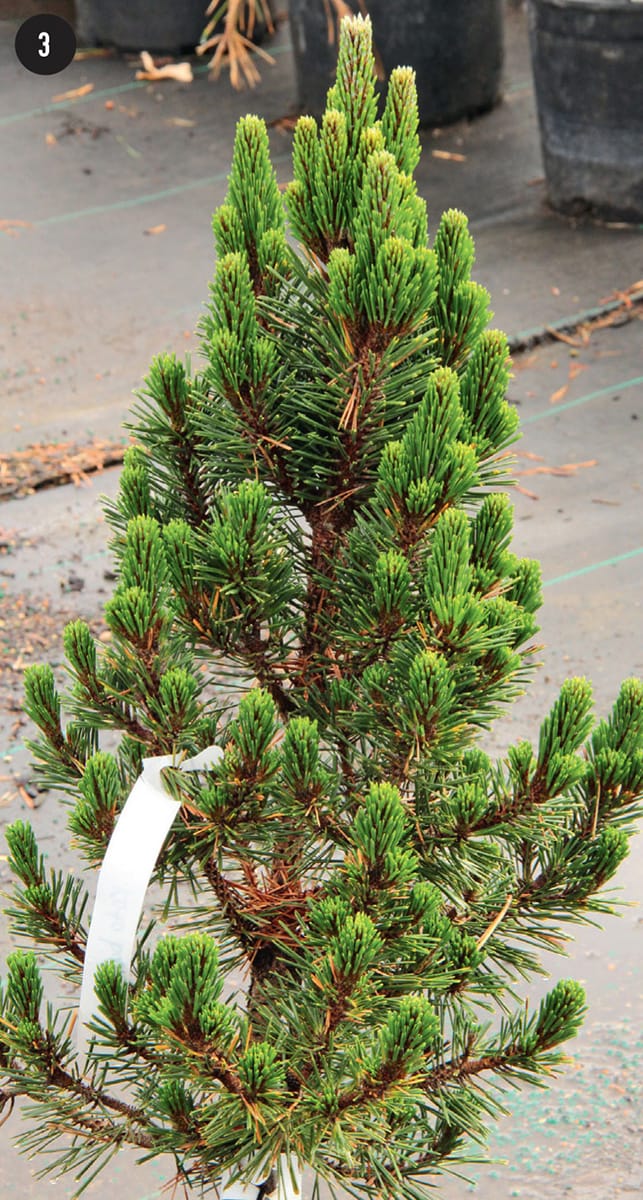
4. DWARF PENCIL POINT JUNIPER (JUNIPERUS COMMUNIS ‘COMPRESSA’): Evergreen and columnar in form, dwarf pencil point juniper is both unique and slow growing. With an average height of 5 feet and a width of just 1 foot, this sun-loving evergreen has blue-green needles. Female plants may produce blue “berries” in the fall, as well. Its tapered form means it’s a great “exclamation point” accent plant for smaller landscapes. Winter hardy down to –40°F.
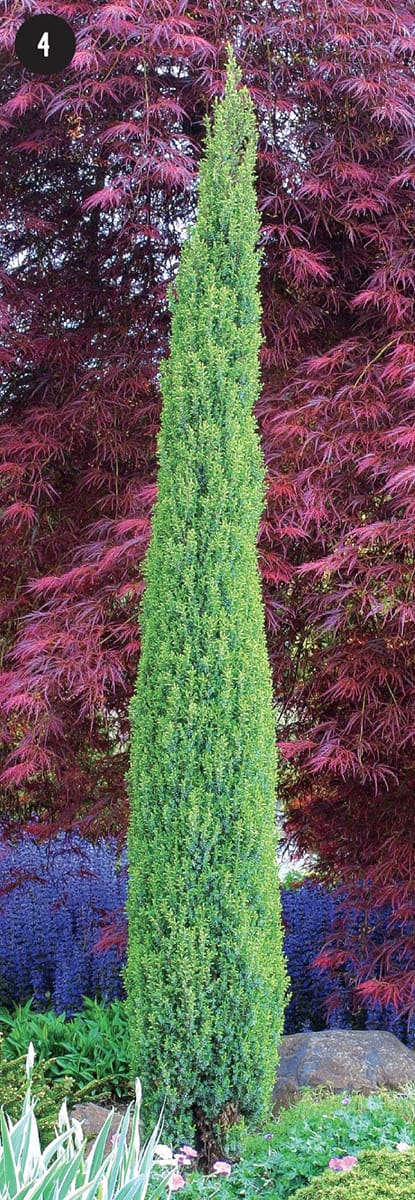
5. DWARF JAPANESE HOLLY (ILEX CRENATA ‘DWARF PAGODA’): This is such a great little plant! Reaching just 3 feet tall and 1 to 2 feet wide at maturity, miniature Japanese holly is super slow growing (it grows only about an inch a year!) and winter hardy down to –20°F. Preferring full sun to light shade, the tiny, round, evergreen leaves are glossy and dark green; and they’re stacked against each other in rows along the stems, giving the plant a really interesting appearance. Introduced through Rutgers University, this selection looks like a funky bonsai plant and is excellent for rock gardens and patio beds.
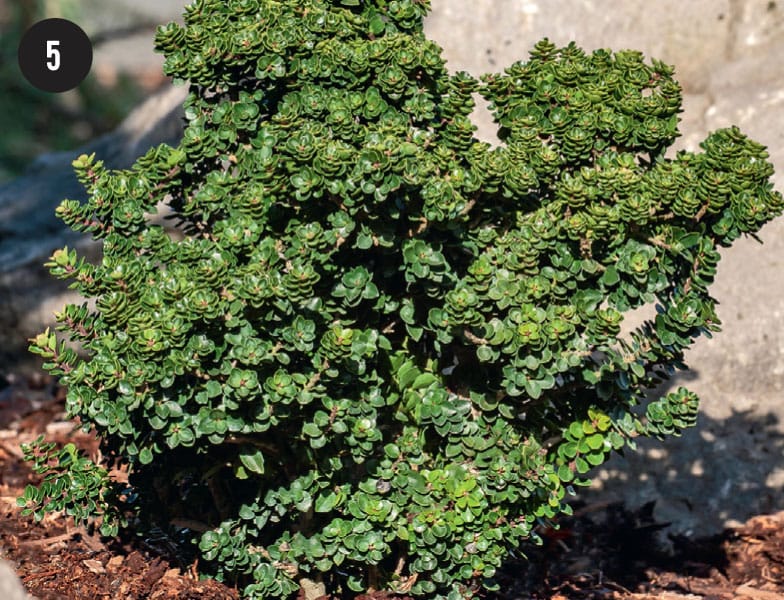
6. UPRIGHT JAPANESE PLUM YEW (CEPHALOXATUS HARRINGTONIA ‘FASTIGIATA’): This broad-needled evergreen is winter hardy down to –10°F. Its upright, slender growth habit maxes out at 8 feet tall and 3 feet wide. Though it’s nonflowering, Japanese plum yews have dark green needles that are densely spaced on bottlebrush-like, upright branches. Each needle is about 2 inches long. It thrives in full to partial sun but prefers afternoon shade in hot southern regions during the summer months.

7. COMPACT OREGON HOLLY GRAPE (MAHONIA AQUIFOLIUM ‘COMPACTA’): Oregon holly grapes are attention-grabbing plants, and this compact selection is no different. The new growth is bronze colored, and it ages to a deep, glossy green. Then in fall, the foliage turns a rich purple-red. The fragrant yellow flowers in spring are followed by elongated clusters of purple, grape-like fruits in the summer and fall. With a low and spreading growth habit, compact Oregon holly grape adapts well to shadier spots, but be forewarned that the edges of the leaves have sharp spines. Useful as a low hedge or underplanting, this selection matures at 2 to 3 feet tall and 3 to 4 feet wide, and is winter hardy down to –20°F.
8. LITTLE GIANT DWARF ARBORVITAE (THUJA OCCIDENTALIS ‘LITTLE GIANT’): Most people think of arborvitae as being tall and cone shaped, but this compact variety is globe shaped, reaching just 4 feet tall and wide. Winter hardy down to –40°F, this slow-growing, rounded shrub produces soft, feathery, fan-shaped foliage. Its tidy shape needs no pruning, making it a terrific choice for foundation plantings, low hedges, or along garden edges.
CHALLENGE #8: NOT ENOUGH POLLINATORS
Gardens can be really beautiful places, full of color and interest, that bring peace and joy to those who tend and visit them. But, gardens also serve purposes far beyond their beauty. Gardens foster and support pollinators and other insects, increase local biodiversity, and provide food and shelter for many species of mammals, amphibians, reptiles, and birds. Selecting plants and planning a garden that benefits nonhuman creatures, too, is of increasing importance as natural habitats disappear.
Whether you want to provide nectar and habitat for pollinators simply to improve your garden’s biodiversity or you’re aiming to increase pollination for your edibles, here are some of the best compact plants to attract and support a broad diversity of pollinating insects.
Compact plants to attract pollinators
1. MAGICAL® MOONLIGHT BUTTONBUSH (CEPHALANTHUS OCCIDENTALIS ‘MOONLIGHT’): A compact version of a North American native shrub, Magical® Moonlight buttonbush is an exceptional pollinator plant. It lures and supports bees, hummingbirds, and butterflies while in bloom. Standing at half the height and width of the straight species, this cultivar matures at just 5 to 8 feet tall and 4 to 6 feet wide. A very adaptable shrub that produces golf ball–sized, creamy-white, round flower clusters in late spring, buttonbush thrives in full sun to part shade and is winter hardy down to –20°F. Pollinators pack the bloom clusters for their pollen and nectar. Great for bogs and poorly drained sites, buttonbush also performs like a champ in regular garden soils, too.
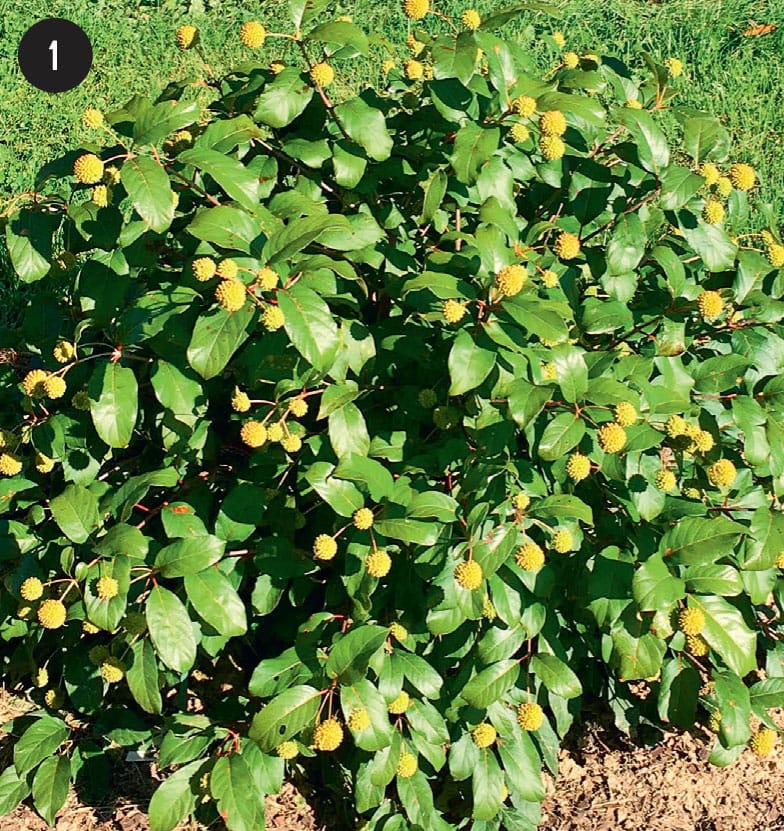
2. LITTLE HENRY® VIRGINIA SWEETSPIRE (ITEA VIRGINICA ‘LITTLE HENRY’): A longtime favorite of mine, this small-statured Virginia sweetspire is covered with pendulous clusters of fragrant, white flowers in the spring. In the fall, the thick, medium green foliage turns a brilliant red. This is a cultivar of a North American native shrub that the pollinators absolutely adore. It maxes out at about 2 to 3 feet tall and wide and is winter hardy down to –20°F.

3. SAPPHIRE SURF™ BLUEBEARD (CARYOPTERIS × CLANDONENSIS ‘BLAUER SPLATZ’): A low-maintenance, mounding shrub with deep blue blooms that will knock your socks off, this compact version of the blue mist shrub is all that and a bag of chips. Reaching just 2 feet tall and 3 feet wide, this deer-resistant shrub is smothered in flat-topped, fuzzy flower clusters in late summer through fall. The blooms are covered with a variety of bee species every day, from sunrise to sunset. Requiring full sun and winter hardy down to –20°F, Sapphire Surf’s only care requirement is an early spring haircut, when its woody stems should be cut down to about 8 to 10 inches in height.

4. BUTTERFLY™ JULIA CONEFLOWER (ECHINACEA ‘JULIA’): Coneflowers are the darlings of perennial gardeners everywhere. But, urban gardeners with limited space may find they take up far too much room. Enter Butterfly™ Julia coneflower. Reaching just 15 inches tall, this selection is sturdy, compact, strong, and floriferous. Tangerine-colored, 4-inch-wide flowers are produced from midsummer through early fall. Single-petaled coneflowers like this one are generally better for pollinators than double-flowered types, as their nectaries are more accessible. Shrugging off winters down to –30°F, coneflowers require full sun; and they make a great cut flower, too.
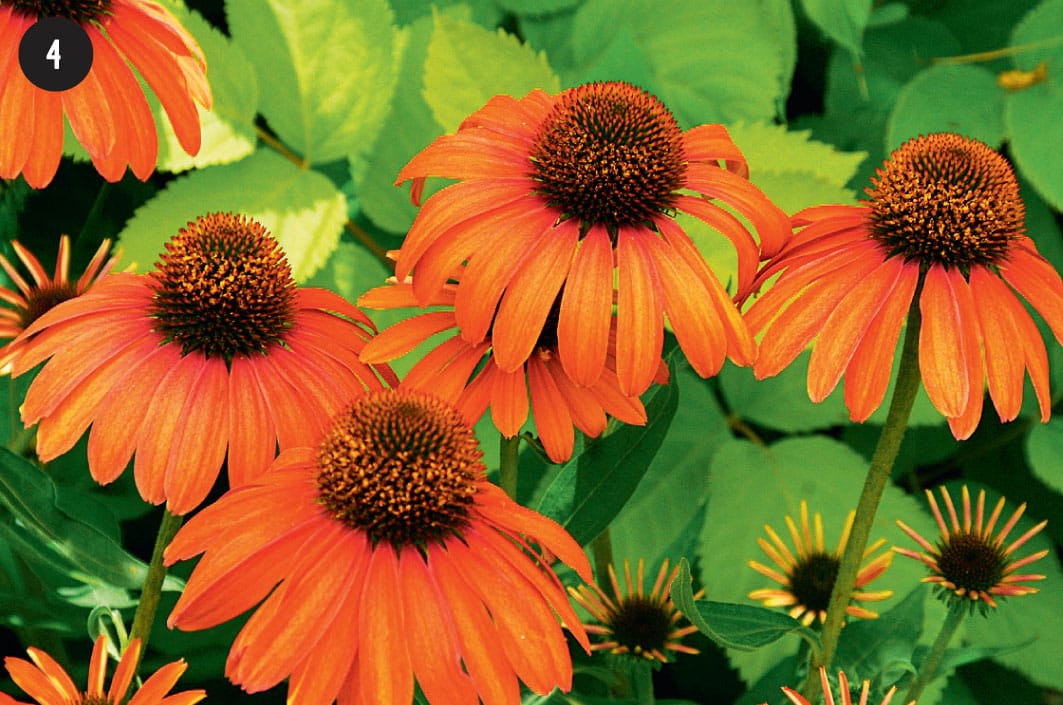
5. PURPLE DOME NEW ENGLAND ASTER (SYMPHYOTRICHUM NOVAE-ANGLIAE ‘PURPLE DOME’): If you’re looking for late-season color in an itty-bitty perennial package, ‘Purple Dome’ aster has you covered. With its mounding form and bushy growth habit, this cultivar of a North American native plant blooms in early fall with hundreds of deep purple, 1/2-inch-wide blooms graced with yellow centers. The entire plant is covered in color when this variety is in bloom. An excellent late-season nectar source for pollinators that’s winter hardy down to –30°F, ‘Purple Dome’ reaches just 12 to 18 inches tall and 3 feet wide with no staking required.
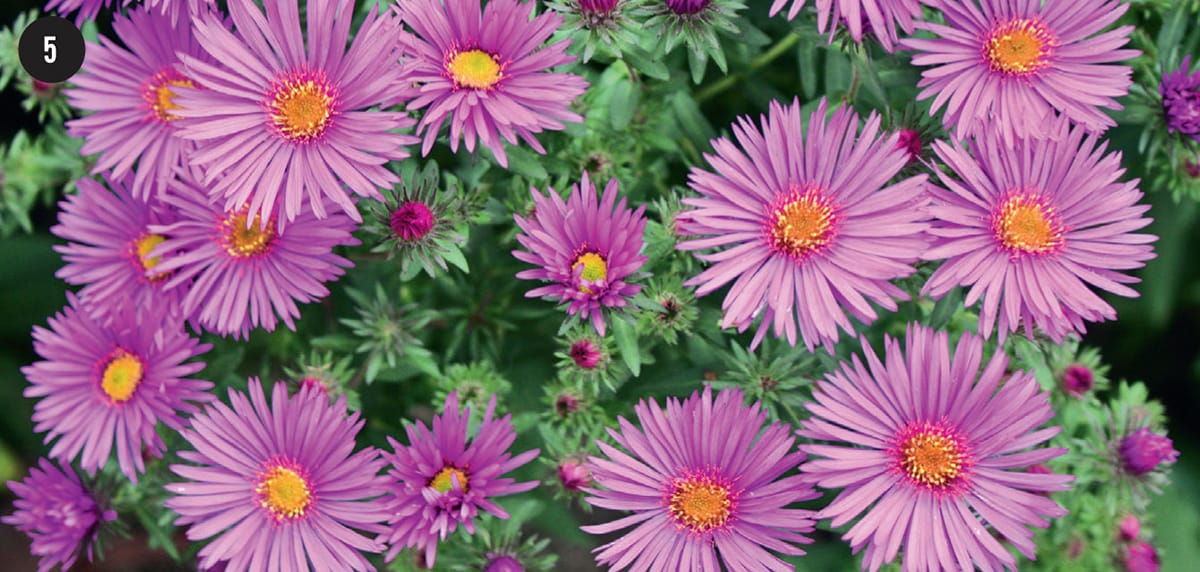
6. PARDON MY PURPLE DWARF BEE BALM (MONARDA DIDYMA ‘PARDON MY PURPLE’): A summer-blooming perennial that’s winter hardy down to –30°F, this compact bee balm requires little more than full sun and average garden soil. In bloom for weeks at a time, it maxes out at just 10 to 12 inches tall, making it the perfect choice for small-scale pollinator gardens. A cultivar of a North American native plant, ‘Pardon My Purple’ is a pint-sized version of a garden favorite. The flowers are deep fuchsia purple, and both the flowers and the deer- and powdery mildew-resistant foliage are edible and make a wonderful herbal tea when dried. This variety is one of several selections in the Pardon My series of compact monardas. Other varieties produce light pink, lavender, and cerise blooms.

7. BLACK ADDER ANISE HYSSOP (AGASTACHE RUGOSUM × A. FOENICULUM ‘BLACK ADDER’): The slender, bottlebrush-shaped, bright blue flower clusters of ‘Black Adder’ hyssop are a favorite of many species of bees. In bloom from midsummer until frost, this licorice-scented plant looks great in containers and garden beds. With a mature height and width of 2 to 3 feet and a winter hardiness of –10°F, ‘Black Adder’ forms an upright clump that’s a good foot shorter than other varieties of this perennial. And as an added bonus, anise hyssop is deer, drought, and heat resistant, too.
